MyBinding Gbc F60H Manual User
2013-06-04
User Manual: MyBinding Gbc-F60H-Manual
Open the PDF directly: View PDF ![]() .
.
Page Count: 110 [warning: Documents this large are best viewed by clicking the View PDF Link!]

WARNNG
ACHTUN
MS N AR
PRO-TECH
F-60 H
GBC Pro - Tech
4151 Anderson Road
DeForest, WI 53532
Revision : A Ph: ( 608 ) 246 - 8844
Fx: ( 608 ) 246 - 8645
FALCON 60 H
OPERATION & MAINTENANCE
MANUAL
© APRIL 2001 GENERAL BINDING CORPORATION. ALL RIGHTS RESERVED.
Do not duplicate without written permission.
Part number : 930 - 063

Read me fileF 60 H Operation and Maintenance Manual
© April 2001 General Binding Corporation
Read Me File . . . . . . . . .
The information in this publication is provided for reference and is believed to be accu-
rate and complete. General Binding Corporation is not liable for errors in this publication or for
incidental or consequential damage in connection with the furnishing or use of the information
in this publication, including, but not limited to, any implied warranty of fitness or merchantabil-
ity for any particular use.
General Binding Corporation reserves the right to make changes to this publication and
to the products described in it without notice. All specifications and information concerning
products are subject to change without notice.
Reference in this publication to information or products protected by copyright or patent
does not convey any license under the rights of General Binding Corporation or others. General
Binding Corporation assumes no liability arising from infringements of patents or any other
rights of third parties.
This publication is copyrighted © 2001 by General Binding Corporation. All rights re-
served. The information contained in this publication is proprietary and may not be repro-
duced, stored, transmitted, or transferred, in whole or in part, in any form without the prior and
express written permission of the Genral Binding Corporation.
The following information will explain how to move around within the electronic version
of this publication. The hand will change to a pointer finger identifying hyperlinked areas. When
moving from page to page, use to return to the first PAGE, use to advance to the last
PAGE, use to go back one PAGE and use to advance one PAGE. When moving
from view to view, use to return to a previous VIEW and use to advance to the next
VIEW.
Should you find an error within this publication or would like to make a suggestion,
please utilize the fax correspondence sheet following this read me file and fax it to the number
provided. Your comments and help will ensure up to date information. Thank you.

Read me file F 60 H Operation and Maintenance Manual
© April 2001 General Binding Corporation
This page intentionally left blank.

Read me fileF 60 H Operation and Maintenance Manual
© April 2001 General Binding Corporation
Fax Correspondence
Fax number : ( 608 ) 246 - 8645 Date :
To : Technical Coordinator at GBC Protech
4151 Anderson Road
DeForest, WI 53532
From :
Company :
Address :
Phone number : ( ) Fax number : ( )
Re : F 60 H Operations and Maintenance Manual ( 930063A )
Section #: Page #:
Correction (s):
Additional comments:

Read me file F 60 H Operation and Maintenance Manual
© April 2001 General Binding Corporation
This page intentionally left blank.

Page I
Table of ContentsF 60 H Operation and Maintenance Manual
© April 2001 General Binding Corporation
Table of Contents
1.0 Safety
1.1 Symbols .......................................................................................................1 - 1
1.2 Safety precautions ......................................................................................1 - 2
1.3 Safety features ............................................................................................1 - 3
1.4 Installation ..................................................................................................1 - 4
1.5 Operations ..................................................................................................1 - 7
1.6 Applications ................................................................................................1 - 9
1.7 Troubleshooting .........................................................................................1 - 10
1.8 Maintenance ...............................................................................................1 - 10
1.9 Decal explanation .......................................................................................1 - 12
Figure 1.9.1 Safety label locations ............................................1 - 14
2.0 Warranty
2.1 Limited warranty information ....................................................................2 - 1
2.2 Exclusions to the warranty ........................................................................2 - 1

Page II
Table of Contents F 60 H Operation and Maintenance Manual
© April 2001 General Binding Corporation
3.0 Specifications
3.1 General .......................................................................................................3 -1
3.2 Consumables ...............................................................................................3 - 2
3.3 Function ......................................................................................................3 - 3
3.4 Electrical ....................................................................................................3 - 4
3.5 Dimensions ................................................................................................3 - 5
Figure 3.5.1 Dimensions ...............................................................3 - 6
4.0 Installation
4.1 Pre-installation check list ...........................................................................4 - 1
Figure 4.1.1 Suggested floor layout .............................................4 - 3
4.2 Know your machine ...................................................................................4 - 4
4.3 Unpacking ..................................................................................................4 - 5
4.4 Shrink wrapped .........................................................................................4 - 5
4.5 Crated .........................................................................................................4 - 6
4.6 Accessory pack content ............................................................................4 - 8

Page III
Table of ContentsF 60 H Operation and Maintenance Manual
© April 2001 General Binding Corporation
4.7 Installing levelers .......................................................................................4 - 9
4.8 Leveling ......................................................................................................4 - 9
4.9 Connecting power ......................................................................................4 - 11
4.10 Safety check ............................................................................................4 - 13
5.0 Operations
5.1 Power ON/ OFF .........................................................................................5 - 2
5.2 Control panel ..............................................................................................5 - 3
Figure 5.2.1 Front control panel ...................................................5 - 4
5.3 Set temperature ..........................................................................................5 - 5
5.4 Load/ unload film ........................................................................................5 - 6
5.5 Unwind brake tension .................................................................................5 - 9
5.6 Rewind brake tension .................................................................................5 - 9
5.7 Setting the nip ...........................................................................................5 - 10
5.8 Footswitch ..................................................................................................5 - 12

Page IV
Table of Contents F 60 H Operation and Maintenance Manual
© April 2001 General Binding Corporation
6.0 Applications
6.1 Helpful hints ...............................................................................................6 - 1
6.2 Temperature conversion chart ...................................................................6 - 3
6.3 Charts and diagrams ..................................................................................6 - 5
Blank chart .......................................................................................................6 - 6
Blank diagram ..................................................................................................6 - 7
Blank diagram w/ roll to roll option ................................................................6 - 9
Chart - Pre-coating substrates ........................................................................6 - 10
Diagram - Pre-coating substrates ...................................................................6 - 11
Chart - Mounting an image ............................................................................6 - 12
Diagram - Mounting an image .......................................................................6 - 13
Chart - PSA decaling ......................................................................................6 - 14
Diagram - PSA decaling .................................................................................6 - 15
Diagram - PSA decaling w/ roll to roll options ..............................................6 - 17
Chart - Lo-Melt decaling ................................................................................6 - 18

Page V
Table of ContentsF 60 H Operation and Maintenance Manual
© April 2001 General Binding Corporation
Diagram - Lo-Melt decaling ...........................................................................6 - 19
Diagram - Lo-Melt decaling w/ roll to roll options .........................................6 - 21
Chart - Mounting a decal ...............................................................................6 - 22
Diagram - Mounting a decal ..........................................................................6 - 23
Chart - PSA single sided lamination ( sled ) ...................................................6 - 24
Diagram - PSA single sided lamination ( sled ) ...............................................6 - 25
Chart - PSA single sided lamination ( craft paper ).........................................6 - 26
Diagram - PSA single sided lamination ( craft paper ) ...................................6 - 27
Diagram - PSA single sided lamination ( craft paper ) w/ roll to roll option ...6 - 29
Chart - PSA over-lamination of a mounted image .........................................6 - 30
Diagram - PSA over-lamination of a mounted image ....................................6 - 31
Chart - Lo-Melt over-lamination of a mounted image ...................................6 - 32
Diagram - Lo-Melt over-lamination of a mounted image ...............................6 - 33

Page VI
Table of Contents F 60 H Operation and Maintenance Manual
© April 2001 General Binding Corporation
7.0 Troubleshooting
7.1 Wave problems ..........................................................................................7 - 1
7.2 Film problems .............................................................................................7 - 3
7.3 Machine problems ......................................................................................7 - 4
7.4 Glossary .....................................................................................................7 - 5
8.0 Maintenance
8.1 Maintenance schedule ................................................................................8 - 1
8.2 Cleaning the rollers ...................................................................................8 - 2
8.3 Clean cabinets and covers ..........................................................................8 - 4
8.4 Clean the control panel ..............................................................................8 - 4
8.5 Chain tensioning .........................................................................................8 - 5

Safety
Page 1 - 1
F 60 H Operation and Maintenance Manual
© April 2001 General Binding Corporation
1.0 Safety
CAUTION
Do not attempt to operate your
Falcon 60 H laminator until you
have read this section carefully!
Your safety, as well as the safety of others, is
important to GBC Films Group. This section contains
important safety information.
The following symbols are used throughout this
manual to indicate Information, Caution, Warning,
Danger and Electrical Shock conditions.
1.1 Symbols
INFORMATION
Indicates helpful information that should be
considered before, during, or after an
action, step or procedure is given.
CAUTION
Indicates a potentially hazardous situation
which, if not avoided, could result in minor
or moderate injury, or alerts against unsafe
practices or alerts against actions which
could damage the product.
WARNING
Indicates a potentially hazardous situation
which, if not avoided, could result in serious
injury.
DANGER
Indicates an imminently hazardous situation
which, if not avoided, could result in death
or serious injury.
ELECTRICAL
SHOCK
Indicates an electrical shock situation which,
if not avoided, could result in serious
paralyzation of the body or death.

Page 1 - 2
Safety F 60 H Operation and Maintenance Manual
© April 2001 General Binding Corporation
1.2 Safety precautions
The Falcon 60 H laminator has been designed
with safety as a primary consideration; however, you must
become thoroughly familiar with the controls, proper
operation, proper service procedures and safety features
of the laminator before using or servicing the unit.
The manual main roller lift mechanism used to
provide downward pressure on the upper main roller is
capable of producing forces greater than 400 pounds.
This force is applied to any object presented in the opening
( called the nip ) between the two rollers.
Use care in lowering the upper laminating roller
and know how to react quickly in an emergency. The
main laminator roll up / down control is located on the
right side of the machine within the front. Before turning
the crank handle to set the GAP down, ensure that nothing
is in the nip area.
WARNING
Keep hands and fingers clear of the
laminator roller nip when adjusting nip.
You can be CRUSHED or BURNED!
In addition, the main laminating rollers of the
Falcon 60 H can reach temperatures up to 200oF (100oC).
DANGER
At these temperatures there is a danger of
severe burn if the rolls are touched during
setup, operation or servicing.
The word qualified is defined below;
Qualified;
• Any engineer that has experience with electrical
and mechanical design of lamination equipment. The
engineers should be fully aware of all aspects of safety
with regards to lamination equipment.
• Any commissioning or service engineer must be
of competent nature, trained and qualified to GBC Films
Group standards to fulfill that job. This person will have
completed and passed the full service training course from
GBC Pro-Tech.
• Any GBC Technician, GBC Specialist, and / or
GBC Films Group Technician that has been through the
GBC Pro-Tech service training course.

Safety
Page 1 - 3
F 60 H Operation and Maintenance Manual
© April 2001 General Binding Corporation
1.3 Safety features
The laminator is equipped with four emergency
stops ( E-STOP ). Two are located at the front of the
cabinets and two are at the rear of the cabinets.
E-STOP
E-STOP
To engage an E-STOP, press down on any of the
four. Any E-STOP, when engaged, removes power to
the laminator.
INFORMATION
The machine will only operate if all four
E-STOPS are in the unlatched position.
To continue operation, all E-STOPs must be in
the unlatched position. To reset, twist the E-STOP 1/4
turn counter clockwise.
1
/
4
tu
r
n
Press RESET located on the control side cabinet
at the rear of the machine just above the main power on/
off.
POWER
Reset
The nip area is protected by a electric photo-eye
which shoots a beam in front of the nip across the width
of the rollers. When this beam is broken, power to the
drive motor is removed. The objetc must be removed to
clear the photo-eye. The motor engage switch must be
pressed again to continue motor operation.
RO T CH
F 60 H
PHOTO-EYE

Page 1 - 4
Safety F 60 H Operation and Maintenance Manual
© April 2001 General Binding Corporation
WARNING
The Falcon 60 H Laminator is a large and
heavy piece of equipment. It is necessary to
employ LICENSED RIGGERS ONLY to
move the laminator. The laminator is not
designed to be tipped up or sideways in any
way. Such action disturbs the exact
alignment of the rolling parts of the machine
and requires extensive realignment. You can
be crushed or seriously injured.
INFORMATION
ALL SHIPMENTS ARE EX-WORKS.
At our
dock, title passes to the buyer. Please review
your insurance coverage prior to shipment,
as you are responsible for all subsequent
freight charges and risks.
INFORMATION
Before signing the Bill of Lading, you
should be sure to inspect the crate
and / or pallet for signs of damage or
missing items; if applicable, make
note of this on the Bill of Lading.
WARNING
The unpacking process requires at least two
people. You can be severely injured, crushed
or cause damage to the laminator.
1.4 Installation
The following symbols are positioned at various
points in Section 4 Installation.
CAUTION
Failure to follow the pre-installation check
list can result in damage to the laminator.
WARNING
The operating environment must be free of
dust, flammable liquids and vapors. You can
be injured by inhaling chemical vapors.
WARNING
Vapor build up or stored flammable
liquids can cause a fire. Excessive
dust can damage the laminator.
CAUTION
Do not locate the Falcon 60 H where air is
blowing directly on the machine. The air
flow can cool the rolls unevenly and result
in poor output quality.

Safety
Page 1 - 5
F 60 H Operation and Maintenance Manual
© April 2001 General Binding Corporation
INFORMATION
Depending on the destination and customer
preference, your machine may be shipped in
various ways. The laminator may arrive
shrink wrapped or in a plywood crate on a
skid. Please follow the unpacking procedure
that pertains to your method of shipment.
CAUTION
Do not use a knife or other sharp object to
remove the shrink wrap from around the
laminator. You can cause irreparable
damage to the rollers.
WARNING
Do not attempt to move the laminator across
anything other than a flat level surface
without trained and qualified riggers. You
can be crushed or seriously injured.
GBC Film Group's warranty does not
cover malfunction of the equipment due to
mishandling and / or tipping. GBC Films
Group bears no responsibility for personal
injury or damage due to moving the
laminator improperly.
INFORMATION
CAUTION
Do not allow the top to fall into the crate. It
can damage the laminator.
INFORMATION
Do not put packing screws on the floor.
They can cause problems when trying to roll
the laminator into position or you can
become injured if stepped on.
CAUTION
A second person must support the side
labeled 5 in Figure 4.5.1 It can fall and
damage the laminator or cause harm to you
and others.
WARNING
Do not attempt to use the ramps if they are
not secured to the pallet. Ensure the pallet is
on a flat even surface before attempting to
roll the machine off.

Page 1 - 6
Safety F 60 H Operation and Maintenance Manual
© April 2001 General Binding Corporation
About recycling: The crate components can
be reused for shipping the laminator again
or can be disassembled and the wood and
screws recycled. The shrink wrap is not
recyclable, so it must be discarded.
INFORMATION
CAUTION
Do not move the leveling nut when securing
the inside nut to the cabinet.
You will need the control side cabinet cover
off to connect the electrical power.
INFORMATION
ELECTRICAL
SHOCK
Only a qualified electrician should connect
power to the laminator. You can be severely
shocked, electrocuted or cause a fire if
power is improperly applied.
WARNING
Follow the correct wiring diagram when
supplying power to the laminator. If
improperly connected, you can be seriously
injured or cause damage to the laminator.
WARNING
Do not wear ties, loose fit clothing or
dangling jewelry while operating or
servicing the laminator. These items can get
caught in the nip and choke you or you can
be crushed or burned.
WARNING
If a safety feature is not working
properly, contact your local service
representative immediately.
CAUTION
Do not use a hard substrate or a substrate
with sharp edges. You may cause damage to
the laminating rollers!

Safety
Page 1 - 7
F 60 H Operation and Maintenance Manual
© April 2001 General Binding Corporation
1.5 Operations
The following symbols are positioned at various
points in Section 5 Operations.
WARNING
Do not wear ties, loose fit clothing or
dangling jewelry while operating or
servicing the laminator. These items can get
caught in the nip and choke you or you can
be crushed or burned.
INFORMATION
The machine will only operate if all
four emergency stops are unlatched and
RESET has been pressed.
It is unsafe to sheet feed without the
pressure plate properly placed on
the front feed table.
WARNING
WARNING
Keep hands and fingers clear of the
laminator roller nip when changing GAP.
You can be CRUSHED or BURNED!
WARNING
When the laminator rollers are in
motion, keep hands and fingers
away from the nip of the rollers.
You may be CRUSHED or BURNED!
WARNING
When operating the laminator using the
footswitch, keep hands and fingers
away from the nip of the rollers.
You may be CRUSHED or BURNED!
WARNING
Do not operate the laminator, except
during web set up, without the front
and rear feed tables in position.
Ensure the roll of laminate is loaded
properly on the unwind shaft.
Exposed adhesive should be facing
away from the rollers.
This will prevent hours of roll cleaning!
CAUTION
INFORMATION
The Poly-in/ Poly-out diagrams refer to the
upper rolls of film only. The mount adhesive
and craft papers are for reference only.

Page 1 - 8
Safety F 60 H Operation and Maintenance Manual
© April 2001 General Binding Corporation
Never leave the unwind shaft out of the
unwind support saddle unless loading
or unloading film.
WARNING
When using two rolls on the machine,
ensure the film widths are identical.
Exposed adhesive can cause complications.
CAUTION
Never use an open blade near the laminating
rollers. You may cut the rollers or your self.
CAUTION
Always use the minimum amount
of brake for the job.
INFORMATION
If more brake is needed, add an O-ring
to the brake side of the rewind.
INFORMATION
CAUTION
Excess pressure can damage the laminating
rollers. Always use the minimum roll
pressure necessary to complete the task.
CAUTION
Objects other than media, film or approved
substrates, will cause irreparable damage
to the rollers if caught in the nip.
CAUTION
Sharp edges on a substrate
should be filed smooth.
Sharp edges can CUT the rollers!
Excessive pressure will cause the
substrate to bow or flatten.
INFORMATION
Density of the substrate will determine the
amount of pressure you may use.
INFORMATION

Safety
Page 1 - 9
F 60 H Operation and Maintenance Manual
© April 2001 General Binding Corporation
1.6 Applications
The following symbols are positioned at various
points in Section 6 Applications.
WARNING
Do not wear ties, loose fit clothing or
dangling jewelry while operating or
servicing the laminator. These items can get
caught in the nip and choke you or you can
be crushed or burned.
INFORMATION
Use film brake tension to control the
separation point of the release liner.
Speeds and temperatures will affect the
bond strength of Lo-Melt adhesives.
INFORMATION
The mount adhesive must not exceed 1 in.
the width of the substrate. If it does, you
will experience complications with this
application.
INFORMATION
Excessive pressure will cause the
substrate to bow or flatten.
INFORMATION
Excessive brake tension may cause the
image to curl. Always use the minimum
amount of brake for the job.
INFORMATION
CAUTION
Excess pressure can damage the laminating
rollers. Always use the minimum roll
pressure necessary to complete the task.
Never stop the laminator when an image is
within the nip of the rollers.
INFORMATION
Laminates and papers should always be
stored in a controlled enviroment.
INFORMATION

Page 1 - 10
Safety F 60 H Operation and Maintenance Manual
© April 2001 General Binding Corporation
1.7 Troubleshooting
The following symbols are positioned at various
points in Section 7 Troubleshooting.
WARNING
Do not wear ties, loose fitting clothing or
dangling jewelry while operating or
servicing the laminator. These items can get
caught in the nip and choke you or you can
be crushed or burned.
INFORMATION
For optimal temperature settings of
various laminates, contact your
supplier or sales representative.
1.8 Maintenance
The following symbols are positioned at various
points in Section 8 Maintenance.
WARNING
Do not wear ties, loose fit clothing or
dangling jewelry while operating or
servicing the laminator. These items can get
caught in the nip and choke you or you can
be crushed or burned.
INFORMATION
Improper maintenance, can
result in poor output quality.
ELECTRICAL
SHOCK
Remove power from the laminator before
servicing. You can be severely shocked,
electrocuted or cause a fire.
INFORMATION
Below is a recommended maintenance
schedule. Before performing any of the steps
listed, read through the procedures first.
Please follow the instructions pertaining to
the step you are performing.

Safety
Page 1 - 11
F 60 H Operation and Maintenance Manual
© April 2001 General Binding Corporation
CAUTION
Excessive pressure can destroy the silicone
layer by pressing to hard or scrubbing
too long in one spot.
CAUTION
Exercise care when cleaning the laminating
rollers with 80% isopropyl alcohol:
Use only in a well ventilated area
Wear rubber gloves
Use only on cool rolls
CLEANING HEATED ROLLERS CAN
IGNITE THE FUMES!
CAUTION
Do NOT pick or pull heat activated adhesive
off the rolls when they are cold. You can
cause irreparable damage to the
laminating rolls.
WARNING
When operating the laminator using the
footswitch, keep hands and fingers
away from the nip of the rollers.
You may be CRUSHED or BURNED!
ELECTRICAL
SHOCK
Remove power from the laminator before
cleaning. You can be severely shocked,
electrocuted or cause a fire.
ELECTRICAL
SHOCK
Do not use liquid or aerosol cleaners on the
laminator. Do not spill liquid of any kind on
the laminator. You can be severely shocked,
electrocuted or cause a fire. Use only a damp
cloth for cleaning unless other wise
specified.
Remove ALL power to the laminator before
removing any cabinet covers.
You may be shocked or electrocuted!
WARNING
WARNING
Always practice lock out/ tag out procedures
when performing any type of service or
maintenance work on the machine.
INFORMATION
The motor controls the tension of the both
chains. If one chain is still too loose,
a half link may be removed.

Page 1 - 12
Safety F 60 H Operation and Maintenance Manual
© April 2001 General Binding Corporation
1.9 Label locations
Posted at various locations on the Falcon 60 H
Laminator are important safety labels. Pay careful
attention to these labels at all times! Figure 1.12.1
illustrates the location of each of these labels.
DANGER
HAZARDOUS
VOLTAGE
!
GEFAHR
!
To be serviced only
by trained and
authorized personnel.
Lockout power before
servicing
Hazardous Voltage: Do not open these cabinets. This
machine is to be serviced only by trained and authorized
personnel.
!
!
!
WARNING
ACHTUNG
MISE EN GARDE
Crush and burn
hazard. Sta
y
clear
of movin
g
rollers.
Stop machine and
raise roll before
cleanin
g
.
Roller Pinch Point: Keep hands and fingers away.
You may be crushed and/ or burned.
!
!
!
WARNING
ACHTUNG
MISE EN GARDE
Moving parts can
crush and cut.
Moving Parts: Keep hands and fingers away. You
may be crushed and/ or cut.
!
!
!
WARNING
ACHTUNG
MISE EN GARDE
Carefully read Operator's
Manual before handling
this machine. Observe
instructions and safety
rules when operating.
Read Manual: Read and understand the Operations
Manual before attempting to run this machine.

Safety
Page 1 - 13
F 60 H Operation and Maintenance Manual
© April 2001 General Binding Corporation
Electrical Shock: Live voltage present. Exercise
extreme caution. You may be electrocuted!
Lift Here: This point may be used as a lifting point. If
ignored, damage will occur to the laminator.
Reset: Machine reset. Press after initiating power to the
laminator or after an E-STOP or E-CABLE has been
engaged then reset.
Refer to Figure 1.9.1 Label Placement illustrates
the location of each of these labels.

Page 1 - 14
Safety F 60 H Operation and Maintenance Manual
© April 2001 General Binding Corporation
Figure 1.9.1 Safety label locations
ARNN
AH U
MS N
PRO-TECH
F-60 H
WARNING
ACHTUNG
MISE EN GARDE
Crush and burn
hazard. Stay clear
of moving rollers.
Stop machine and
raise roll before
cleaning.
WARNING
ACHTUNG
MISE EN GARDE
Carefully read operator's
Manual before handling
this machine. Observe
instructions and safety
rules when operating.
(Inside cabinet)
WARNING
ACHTUNG
MISE EN GARDE
Moving parts can
cruch and cut.
(Inside cabinet)
!
!
DANGER
GEFAHR
HAZARDOUS
VOLTAGE
To be serviced only
by trained and
authorized personnel.
Lockout power before
servicing

Page 2 - 1
WarrantyF 60 H Operation and Maintenance Manual
© April 2001 General Binding Corporation
2.0 Warranty
GBC Films Group warrants the equipment sold
is free from defects in material and workmanship for a
period of one ( 1 ) year parts ( excludes normal wear
items ) and 90 days labor from the date of installation.
This warranty is the only warranty made by GBC Films
Group and cannot be modified or amended.
GBC Films Group’s sole and exclusive
liability and the customer’s sole and exclusive
remedy under this warranty shall be, at GBC Films
Group’s option, to repair or replace any such
defective part or product. These remedies are only
available if GBC Films Group’s examination of the
product discloses to GBC Films Group’s satisfaction
that such defects actually exist and were not caused
by misuse, neglect, attempt to repair, unauthorized
alteration or modification, incorrect line voltage, fire,
accident, flood, or other hazard.
2.1 Limited Warranty
This warranty specifically does not cover damage
to the laminating rollers caused by knives, razor blades,
other sharp objects, failure caused by adhesives or
improper use of the machine. Warranty repair or
replacement does not extend the warranty beyond the
initial one year period from the date of delivery.
CAUTION
Unauthorized customer alterations will
void this warranty.
THE WARRANTY MADE HEREIN IS IN
LIEU OF ALL OTHER WARRANTIES,
EXPRESS OR IMPLIED, INCLUDING
ANY WARRANTY OR
MERCHANTABILITY OR FITNESS
FOR A PARTICULAR PURPOSE. GBC
FILMS GROUP WILL NOT BE LIABLE
FOR PROPERTY DAMAGE OR
PERSONAL INJURY ( UNLESS
PRIMARILY CAUSED BY ITS
NEGLIGENCE ), LOSS OF PROFIT OR
OTHER INCIDENTAL OR
CONSEQUENTIAL DAMAGES
ARISING OUT OF THE USE OR
INABILITY TO USE THE EQUIPMENT.
2.2 Exclusions to the
Warranty
This warranty specifically does not
cover;
1. Damage to the laminating rollers caused by knives,
razor blades, other sharp objects or failure caused
by adhesives.
2. Damage to the machine caused by lifting, tilting and /
or any attempt to position the machine other than
rolling on the installed castors on even surfaces.
3. Improper use of the machine.
4. Damage due from unqualified person(s) servicing the
machine.

Page 2 - 2
Warranty F 60 H Operation and Maintenance Manual
© April 2001 General Binding Corporation
Qualified
• Any engineer that has experience with electrical
and mechanical design of lamination equipment. The
engineers should be fully aware of all aspects of safety
with regards to lamination equipment.
• Any commissioning or service engineer must be
of competent nature, trained and qualified to GBC Films
Group standards to fulfill that job. This person will have
completed and passed the full service training course from
GBC Pro-Tech.
• Any GBC Technician, GBC Specialist, and / or
GBC Films Group Technician that has been through the
GBC Pro-Tech service training course.

Page 3 - 1
SpecificationsF 60 H Operation and Maintenance Manual
© April 2001 General Binding Corporation
3.0 Specifications
Specifications provide all of the technical data for
the Falcon 60 H Laminator.
3.1 General
Description:
Features:
Applications:
• Cost efficient, wide format color finisher for the sheet
fed ink jet market. The Falcon 60 H is a self standing,
bi-directional cold mounter and laminator with the abilty
to run Lo-Melt overlaminate.
• Two unwinds ( 1 upper, 1 center/ front )
• One rewind ( upper front )
• Infeed and oufeed tables
• Footswitch
• Front and rear table idlers
• Bi-directional system
• Four E-STOPs
• Photo-eye nip protection
• Roll to roll capability ( option)
• Single sided lamination
• Mounting
• Decaling
• Low melt film

Page 3 - 2
Specifications F 60 H Operation and Maintenance Manual
© April 2001 General Binding Corporation
3.2 Consumable
Film types:
Film diameters:
Core size:
Film widths:
Paper widths:
Mounting thickness:
Safety:
• Pressure sensitive laminates
• Pressure sensitive adhesives
• Low melt laminates
• Up to a 8 in. roll diameter ( 20.3 cm )
• 3 in. core standard ( 7.62 cm )
• 2-1/4 in. optional ( must have optional core adapters )
( 5.72 cm )
• 62 in. Pressure sensitive ( 162.6 cm )
• 60 in. Low Melt ( 157.8 cm )
• 62 in. maximum paper width ( 157.8 cm )
• Up to 1 in. thick ( 2.54 cm ) either direction
• Designed to UL safety standards

Page 3 - 3
SpecificationsF 60 H Operation and Maintenance Manual
© April 2001 General Binding Corporation
3.3 Function
Speed:
Motor:
Heating capabilities:
Controls:
Roll design:
• 0 - 16 ft / min ( 0 - 4.6 m / min )
• 2-1/4 horse power drive motor
• Bi-directional D.C. motor
• 68oF - 200oF ( 20oC - 93oC )
• Front control panel
• Footswitch
• High release silicone rollers

Page 3 - 4
Specifications F 60 H Operation and Maintenance Manual
© April 2001 General Binding Corporation
3.4 Electrical
United Statesand Canada:
B.T.U. output:
Heater wattages:
Amperage draw:
D/C voltage used:
A/C voltage used:
• 230 ~ 240 VAC, 50/60 Hz, single phase, 40 amps
• 18,520 B.T.U. / hour
• 5429 watts per heater @ 240 vac
• No heat, motor only : 1 - 3 amps
• Top heat and motor : 25 - 30 amps
• 24 vdc
• 230~ 240 vac ( minimum )

Page 3 - 5
SpecificationsF 60 H Operation and Maintenance Manual
© April 2001 General Binding Corporation
3.5 Dimensions
Weight:
Uncrated:
Crated:
Dimensions
Uncrated:
Crated
Nip Height:
• 1350 lbs. ( 612 kg. )
• 1625 lbs. ( 737 kg. )
• 80 in. (L) x 38.5 in. (W) x 57 in. (H)
( 203 cm (H) x 98 cm (W) x 145 cm (L) )
Refer to Figure 3.5.1 Dimensions
• 90 in. (L) x 44 in. (W) x 68 in. (H)
( 229 cm (H) x 112 cm (W) x 173 cm (L) )
• 38 in. ( 96.5 cm )

Page 3 - 6
Specifications F 60 H Operation and Maintenance Manual
© April 2001 General Binding Corporation
Figure 3.5.1 Dimensions
WARNING
ACHTUNG
MS N AR
PRO-TECH
F-60 H
57 in.
( 145 cm )
80 in.
( 203 cm )
38.5 in.
( 98 cm )

Page 4 - 1
InstallationF 60 H Operation and Maintenance Manual
© April 2001 General Binding Corporation
Is the environment appropriate for the laminator?
The laminator requires a clean, dust and vapor
free environment to operate properly. Do not
locate it where there is air blowing directly on the
machine.
Have you contacted a certified electrician to both
wire the laminator and ensure that adequate power
is being supplied, having the appropriate capacity,
over current protection and safety lockouts are
available?
WARNING
The operating environment must be free of
dust, flammable liquids and vapors. You can
be injured by inhaling chemical vapors.
WARNING
Vapor build up or stored flammable
liquids can cause a fire. Excessive
dust can damage the laminator.
CAUTION
Do not locate the Falcon 60 H where air is
blowing directly on the machine. The air
flow can cool the rolls unevenly and result
in poor output quality.
4.0 Installation
GBC Films Group is committed to a program of
ongoing product improvement. As a result, we are
providing these instructions so you can insure that your
new Falcon 60 H Laminator is properly and securely
unpacked, moved, and installed. Installation should be
performed by a qualified technician.
Before a Falcon 60 H Laminator can be installed,
there are a few requirements that must be met. Make
certain that each of the requirements listed in the following
pre-installation checklist are met before beginning
installation.
CAUTION
Failure to follow the pre-installation check
list can result in damage to the laminator.
4.1 Pre-installation
Are doorways and hallways wide enough for the
laminator to be moved to the installation site?
Is there ample room for the laminator?
A work area must be established that allows for
operation in both the front and rear of the
laminator and provides space for efficient material
flow. Figure 4.1.1 illustrates a typical machine
area layout.

Page 4 - 2
Installation F 60 H Operation and Maintenance Manual
© April 2001 General Binding Corporation
The Falcon 60 H requires single phase, 230 to
240 vac, 50/ 60 Hz, 40 amp service. No other
type of connection is permitted.
WARNING
The Falcon 60 H Laminator is a large and
heavy piece of equipment. It is necessary to
employ LICENSED RIGGERS ONLY to
move the laminator. The laminator is not
designed to be tipped up or sideways in any
way. Such action disturbs the exact
alignment of the rolling parts of the machine
and requires extensive realignment. You can
be crushed or seriously injured.
For instructions on how to connect power,
proceed to 4.9 Connecting power in this section.

Page 4 - 3
InstallationF 60 H Operation and Maintenance Manual
© April 2001 General Binding Corporation
Figure 4.1.1 Suggested Floor Layout
4 ft. x 6 ft. (1.22 m x 2 m)
Work table on wheels
Table height
37-3/4 in. (.95 - .96 m)
4 ft. x 6 ft. (1.22 m x 2 m)
Work table on wheels
Table height
37-3/4 in. (.95 - .96 m)
3 ft. ( 1 m )
13' ( 4 m)
20 ft.
( 6 m )
78 in.
( 2 m )
8.2 ft.
( 2.57 m )
38.5"
( .98 m )
8.2 ft.
( 2.57m )
Front operating position
Electrical
supply

Page 4 - 4
Installation F 60 H Operation and Maintenance Manual
© April 2001 General Binding Corporation
4.2 Know your machine
Before performing any procedure within this
manual, it is recommended that you take time to know
the parts of your new machine.
Figure 4.2.1 The laminator
Front
Rear
Control side
( Right )
Drive side
( Left )
PRO TECH
F-60 H
Figure 4.2.2 Safety and controls
PRO-TECH
F-60 H
Control panel
Foot switch
Main roller lift
Upper unwind brake
Lower unwind brake
Core grip
E-stop
Core support
Rewind drive
Figure 4.2.3 Idlers and unwinds
PRO TECH
F-60 H
Upper unwind
Lower Unwind
Front table idler
Rear table idler
Web idler
Tie bars
Figure 4.2.4 Misc.
Main rollers
Front table
Rear table
Castors
Unwind saddle
Photo-eye
Run/ Stop
PR -TECH
F-60 H
Figure 4.2.5 Power
POWER
Reset
On/ Off

Page 4 - 5
InstallationF 60 H Operation and Maintenance Manual
© April 2001 General Binding Corporation
4.3 Unpacking
INFORMATION
ALL SHIPMENTS ARE EX-WORKS.
At our
dock, title passes to the buyer. Please review
your insurance coverage prior to shipment,
as you are responsible for all subsequent
freight charges and risks.
INFORMATION
Before signing the Bill of Lading, you
should be sure to inspect the crate
and / or pallet for signs of damage or
missing items; if applicable, make
note of this on the Bill of Lading.
INFORMATION
Depending on the destination and customer
preference, your machine may be shipped in
various ways. The laminator may arrive
shrink wrapped or in a plywood crate on a
skid. Please follow the unpacking procedure
that pertains to your method of shipment.
WARNING
The unpacking process requires at least two
people. You can be severely injured, crushed
or cause damage to the laminator.
With regards to your shipping methods, use one
of the following procedure described to safely and
properly unwrap / uncrate your laminator.
4.4 Shrink Wrapped
a) Inspect the machine for any obvious shipping
damages upon receipt. Report any damage to
your carrier.
b) Carefully unwrap the shrink wrap from around
the laminator.
CAUTION
Do not use a knife or other sharp object to
remove the shrink wrap from around the
laminator. You can cause irreparable
damage to the rollers.
c) Carefully wheel your Falcon 60 H Laminator
with a second person to the installation site.
WARNING
Do not attempt to move the laminator across
anything other than a flat level surface
without trained and qualified riggers. You
can be crushed or seriously injured.

Page 4 - 6
Installation F 60 H Operation and Maintenance Manual
© April 2001 General Binding Corporation
4.5 Crated
WARNING
The Falcon 60 H Laminator is a large and
heavy piece of equipment. It is necessary to
employ LICENSED RIGGERS ONLY to
move the laminator. The laminator is not
designed to be tipped up or sideways in any
way. Such action disturbs the exact
alignment of the rolling parts of the machine
and requires extensive realignment. You can
be crushed or seriously injured.
GBC Film Group's warranty does not
cover malfunction of the equipment due to
mishandling and / or tipping. GBC Films
Group bears no responsibility for personal
injury or damage due to moving the
laminator improperly.
INFORMATION
Tools required
• # 2 Phillips head screwdriver
• 7/8” open end wrench or adjustable wrench
• Crow bar
• A second person
To uncrate the laminator
a) Remove the top of the crate and then the sides
in the order shown in Figure 4.5.1
CAUTION
Do not allow the top to fall into the crate. It
can damage the laminator.
INFORMATION
Do not put packing screws on the floor.
They can cause problems when trying to roll
the laminator into position or you can
become injured if stepped on.
CAUTION
A second person must support the side
labeled 5 in Figure 4.5.1 It can fall and
damage the laminator or cause harm to you
and others.

Page 4 - 7
InstallationF 60 H Operation and Maintenance Manual
© April 2001 General Binding Corporation
Figure 4.5.1 Disassembling of the crate
5
3
A
AU
R E
F-60 H
4
1
2
Removing the shrink wrap
a) Gently unwrap the shrink wrap from around the
laminator.
CAUTION
Do not use a knife or other sharp object to
remove the shrink wrap from around the
laminator. You can cause irreparable
damage to the rollers.
b) Move all packing materials to a safe distance.
Moving the laminator
a) Have the laminator rolled off the skid and placed
on the floor by licensed riggers. The ramps
included with the laminator can be secured utilizing
screws removed from the disassembled crate.
Figure 4.5.2 illustrates positioning of the ramps.
WARNING
Do not attempt to use the ramps if they are
not secured to the pallet. Ensure the pallet is
on a flat even surface before attempting to
roll the machine off.
Figure 4.5.2 Positioning of the ramps
b) Remove any plastic strapping and/or packing
paper taped to the rollers.

Page 4 - 8
Installation F 60 H Operation and Maintenance Manual
© April 2001 General Binding Corporation
4.6 Accessory pack
Once the Falcon 60 H Laminator has been
unpacked and moved into final position, open the accessory
pack and verify the contents.
Accessory Pack contents
• One Fuse, 250 V, 20 amp ( 186 - 135 )
• Two Fuses, 2,5 amp ( 186 - 220 )
• One fuse, 0.5 amp ( 186-016 )
• One Operators Manual ( 930 - 063 )
• One Towel ( 475 - 950 )
• One Zippy knife ( 475 - 620 )
• One strain relief for main power ( 175-201 )
• One rubber cement pad ( 930320 )
• One crank handle ( 629-018 )
• One O-ring ( 480 - 005 )
• Four leveling pads ( 470 - 101 )
• One T-handle, 1/4 in. ( 475 - 210 )
• One roll of masking tape ( 475 - 000 )
• One crank handle ( ??? - ??? )
• One BHCS ( floor stock item )
If you are missing any of the items listed above,
contact your local service technician or sales
representative.
Contacts:
GBC Parts ( 800 ) 790 - 7787
GBC Europe parts 33 - 45 - 535 - 7676
CAUTION
Do not use a knife or other sharp object to
remove the shrink wrap from around the
laminator. You can cause irreparable
damage to the rollers.
c) Remove all packing materials to a safe distance
from the laminator and dispose of properly.
d) Use two people to carefully roll the laminator to
the desired location.
About recycling: The crate components can
be reused for shipping the laminator again
or can be disassembled and the wood and
screws recycled. The shrink wrap is not
recyclable, so it must be discarded.
INFORMATION

Page 4 - 9
InstallationF 60 H Operation and Maintenance Manual
© April 2001 General Binding Corporation
4.7 Installing levelers
Leveling of the machine is a customer option. If
you choose not to level the laminator and you encounter
output problems, please level the machine and try your
application again before calling for technical support.
Tools required
• ( 2 ) 3/4” open end wrenches
• Four leveling pads
( from the accessory pack )
a) Verify that the laminator has sufficient room
around it to load film, walk around and to be
serviced if necessary.
b) Place one leveling pad on each of the four
leveling bolts on the laminator.
Leveling pads
Jam nuts
c) Use a 3/4 in. open end wrench to secure the
jam nut against the leveling pad.
4.8 Leveling
Leveling of the laminator is very important in the
way the machine performs. Leveling is crucial to the tram
( tracking ) of the materials through the machine.
Tools required
• ( 2 ) 3/4 in. open end wrenches
• 1/8 in. allen wrench
• Level
• A second person
a) With a 1/8 in. allen wrench, remove the drive
side and control side cabinet covers by;
1) Loosen the three screws along the
bottom.
2) Remove the seven screws along the
top and sides of the cover.
PRO-TECH
F-60 H
1
2

Page 4 - 10
Installation F 60 H Operation and Maintenance Manual
© April 2001 General Binding Corporation
e) Position the level on the top of the drive side
cabinet.
A
PRO-TECH
F-60 H
f) Level the drive side from front to back by
turning the leveling nut clockwise to raise or
counter clockwise to lower.
g) Position the level center of the upper tie bar.
PRO TECH
F-60 H
h) Level the laminator from drive side to control
side by turning the leveling nut clockwise to
raise or counter clockwise to lower.
b) Loosen the nut on the inside of both cabinets
securing the leveling bolt with a 3/4 in. wrench.
Inside nuts
c) Position the level on the top of the control side
cabinet.
PRO TECH
F-60 H
d) Level the control side from front to back by
turning the leveling nut clockwise to raise or
counter clockwise to lower.
9
Leveling nuts

Page 4 - 11
InstallationF 60 H Operation and Maintenance Manual
© April 2001 General Binding Corporation
i) Verify that all three points are still leveled.
j) Hold the leveling nut in place with a 3/4 in. open
end wrench while you secure the inside nut to
the cabinet. Do this for both sides.
9
Inside nuts
CAUTION
Do not move the leveling nut when securing
the inside nut to the cabinet.
k) Replace the drive side cabinet cover at this time.
You will need the control side cabinet cover
off to connect the electrical power.
INFORMATION
4.9 Connecting power
ELECTRICAL
SHOCK
Only a qualified electrician should connect
power to the laminator. You can be severely
shocked, electrocuted or cause a fire if
power is improperly applied.
Tools required
• 1/8 in. allen wrench
• # 2 phillips head screw driver
• Multi meter
a) Ensure the power at the junction box is in the
OFF position.
b) Feed the power cable through the main power
strain relief from the accessory pack, then
through the hole provided below the circuit
breaker on/ off.
Line Terminal Block
Strain relief
Power cable

Page 4 - 12
Installation F 60 H Operation and Maintenance Manual
© April 2001 General Binding Corporation
c) Connect the wires to the Line Terminal Block
(LTB) as illustrated below.
1
3
5
2
4
6
red wires blue wires
hot leg hot leg ground
WARNING
Follow the correct wiring diagram when
supplying power to the laminator. If
improperly connected, you can be seriously
injured or cause damage to the laminator.
d) Secure the main power strain relief to the
cabinet.
e) Turn the junction box power to the ON
position.
f) Verify line voltage with regards to the type of
power being supplied to the laminator at the line
terminal block.
1
3
5
2
4
6
hot leg
(A)
hot leg
(B)
ground
(C)
• (A) - (B) = 230 ~ 240 VAC
• (A) - (C) = 115 ~ 120 VAC
• (B) - (C) = 115 ~ 120 VAC
g) Replace the control side cabinet cover.
h) Turn the On/ Off to the “ON” position by
flipping the handle to the up position and press
reset.
POWER
Reset
On/ Off

Page 4 - 13
InstallationF 60 H Operation and Maintenance Manual
© April 2001 General Binding Corporation
4.10 Safety check
The safety check will ensure that all safety devices
and interlocks are functioning properly.
This procedure describes how to check one
E-STOP and the PHOTO-EYE. Repeat the steps for
the remaining three E-STOPS. ALL SAFETY
FEATURES MUST BE CHECKED!
WARNING
Do not wear ties, loose fit clothing or
dangling jewelry while operating or
servicing the laminator. These items can get
caught in the nip and choke you or you can
be crushed or burned.
WARNING
If a safety feature is not working
properly, contact your local service
representative immediately.
Contacts:
GBC National Service: ( 800 ) 790 - 7787
My service rep:_____________________
E-STOPs
a) Turn MAIN POWER to ON .
POWER
On
Off
b) Press RESET. The power indicator on the front
control panel will be illuminated.
POWER
Reset
c) Press the motor direction to FORWARD.
(reverse) (forward)

Page 4 - 14
Installation F 60 H Operation and Maintenance Manual
© April 2001 General Binding Corporation
d) Rotate the speed dial to a setting greater than 1.
1
2
3
4567
8
9
10
e) Press the motor engage/ disengage to ENGAGE.
(disengage) (engage)
f) Press the temperature on/off to ON.
(off) (on)
g) Press one of the four E-STOPs.
h) The bottom main roller stops turning, the power
indicator light goes out, the display on the
temperature controller unit goes out.
i) Turn the E-STOP 1/4 turn counter clockwise to
unlatch.
1
/
4
tu
r
n
j) Repeat steps b) through i) for the remaining
three E-STOPs.
PHOTO-EYE
a) Cut a piece of 1/2 inch ( 1.3 cm ) thick foam
board to 4 inches x 6 inches. ( 10 cm x 15 cm )
This piece will be referred to as the “finger board”.
CAUTION
Do not use a hard substrate or a substrate
with sharp edges. You may cause damge to
the laminating rollers.

Page 4 - 15
InstallationF 60 H Operation and Maintenance Manual
© April 2001 General Binding Corporation
b) Ensure all E-STOPs are in the unlatched position
and remove the pressure plate from the front feed
table.
c) If the power indicator on the control panel is not
illuminated, press Reset.
POWER
Reset
d) Set the motor direction to FWD.
(reverse) (forward)
e) Lower the main roller to initial contact ( one bar
on the pressure display is illuminated ).
f) Press the motor engage/ disengage to ENGAGE.
(disengage) (engage)
g) Slide the “finger board” on the front feed table
towards the nip about 10 in. ( 25 cm ) from the
control side.
finger board
h) The rollers should stop just before the finger
board can enter the roller nip.
i) Slide the finger board back away from the rollers
nip. Press the motor engage/ disengage to
ENGAGE.
(disengage) (engage)

Page 4 - 16
Installation F 60 H Operation and Maintenance Manual
© April 2001 General Binding Corporation
j) If the finger board comes in contact with the
rollers while they are turning, contact your
service representative to adjust the PHOTO-
EYEs.
k) Slide the “finger board” towards the roller nip
about center of the front feed table.
finger board
l) The rollers should stop just before the finger
board can enter the roller nip.
m) Slide the finger board back away from the rollers
nip. Press the motor engage/ disengage to
ENGAGE.
(disengage) (engage)
n) If the finger board comes in contact with the
rollers while they are turning, contact your
service representative to adjust the PHOTO-
EYEs.
o) Slide the “finger board” on the front feed table
towards the nip about ten in. ( 25 cm ) from the
control side.
finger board
p) The rollers should stop just before the finger
board can enter the roller nip.
q) Slide the finger board back away from the
rollers nip.
r) If the finger board comes in contact with the
rollers while they are turning, contact your
service representative to adjust the PHOTO-
EYEs.
s) Raise the main roller.

Page 5 - 1
Operations
F 60 H Operation and Maintenance Manual
© April 2001 General Binding Corporation
5.0 Operations
In this section you will find information on how to
properly turn your Falcon 60 H Laminator on, learn
functions of the control panel, increase and decrease
temperature, properly load and unload film, use of the
unwind brake tensioning system, rewind brake tensioning,
how to manually set the nip for mounting, and foot switch
function.
The following general rules should always be
adhered while operating this machine.
WARNING
Do not wear ties, loose fit clothing or
dangling jewelry while operating or
servicing the laminator. These items can get
caught in the nip and choke you or you can
be crushed or burned.
INFORMATION
The machine will only operate if all
four emergency stops are unlatched and
RESET has been pressed.
It is unsafe to sheet feed without the
pressure plate properly placed on
the front feed table.
WARNING
WARNING
When the laminator rollers are in
motion, keep hands and fingers
away from the nip of the rollers.
You may be CRUSHED or BURNED!
WARNING
Keep hands and fingers clear of the
laminator roller nip when changing GAP.
You can be CRUSHED or BURNED!
WARNING
When operating the laminator using the
footswitch, keep hands and fingers away
from the nip of the rollers.
You may be CRUSHED or BURNED!
WARNING
Do not operate the laminator, except
during web set up, without the front
and rear feed tables in position.

Page 5 - 2
Operations F 60 H Operation and Maintenance Manual
© April 2001 General Binding Corporation
5.1 Power On/ Off
Power on
a) Ensure the laminator is plugged in and that all E-
STOPs are in the unlatched position.
1
/
4
tu
r
n
b) Turn the MAIN POWER to the up position.
POWER
On
Off
c) Press RESET located above the main power
on/off.
POWER
Reset
d) Power indicator on the control panel should be
illuminated at this time.
2
4 7
9
00
Power indicator light
Power off
a) Ensure the rollers are in the up position.
b) Turn the MAIN POWER to the down position.
POWER
On
Off

Page 5 - 3
Operations
F 60 H Operation and Maintenance Manual
© April 2001 General Binding Corporation
5.2 Control panel
The operator control panel for the Falcon 60 H
Laminator is located to the right of the front operating
position. For an illustration of the complete front control
panel, please refer to Figure 5.2.1 Falcon 60 H. The
names and functions of these controls are as follows:
( 1 ) NIP PRESSURE DISPLAY: When pressure at
the nip of the rollers is applied, bars on the nip pressure
display are illuminated in increments of 5% up to 100%.
( 2 ) MOTOR ENGAGE/ DISENGAGE: When
pressed to the right, power to the motor is supplied and
the rollers will begin to turn. When pressed to the left,
power to the motor is removed and the rollers stop turning.
(disengage) (engage)
( 3 ) FWD / REV: When pressed to the right, the motor
turns in a forward direction as illustrated by the image
above the switch. When pressed to the left, the motor
turns in a reverse direction.
(reverse) (forward)
( 4 ) SPEED DIAL: When turned clockwise, increases
the speed of the motor. Turning it counter clockwise will
decrease motor speed.
1
2
3
4567
8
9
10
( 5 ) TEMP ON/ OFF: When pressed to the right,
supplies power to the temperature controller unit located
just above it. When pressed to the left, removes power to
the temperature controller unit.
(off) (on)

Page 5 - 4
Operations F 60 H Operation and Maintenance Manual
© April 2001 General Binding Corporation
( 6 ) TEMPERATURE CONTROLLER UNIT :
Displays the current temperature of the upper roller. Allows
the operator to control the operating temperature of the
upper roller. To set temperature refer to Section 5.3.
CAL 3200
Figure 5.2.1 Front control panel
( 7 ) POWER INDICATOR: When illuminated
represents power to the laminator is supplied. If not
illuminated, power to the laminator has been removed via
an E-STOP, no RESET, circuit breaker is the off position
or line voltage has been removed.
1
2
3
4567
8
9
10
CAL 3200
1
2
3
4
6
5
7

Page 5 - 5
Operations
F 60 H Operation and Maintenance Manual
© April 2001 General Binding Corporation
5.3 Set Temperature
The Falcon 60 H has upper roller heating
capabilities which enables the machine to run Lo-Melt
film. You can set a desired temperature from 32 OF
( 0 OC ) up to 200 OF ( 93 OC ).
When power to the temperature controller unit is
supplied, the display indicates the current temperature of
the upper roller.
CAL 3200
(72 is an example of room temperature )
To display the current set point value of the
temperature controller unit, press and hold the star key
located just to the left just below the temperature display.
When the star key is released, the temperature display
reverts to the current temperature of the upper roller.
CAL 3
Increase set point
a) Press and hold ✽ key while pressing ▲ key to
increase the set point temperature. Single presses
of the ▲ key increases the set point by increments
of one while holding the key down will increase
by increments of ones then tens.
CAL 3 0
b) Release the ✽ key and ▲ key once desired set
point has been obtained.
Decrease set point
a) Press and hold ✽ key while pressing ▼ key to
decrease the set point temperature. The same
increments apply.
CAL 3
b) Release the ✽ key and ▼ key once desired set
point has been obtained.

Page 5 - 6
Operations F 60 H Operation and Maintenance Manual
© April 2001 General Binding Corporation
5.4 Load/ Unload film
Ensure the roll of laminate is loaded
properly on the unwind shaft.
Exposed adhesive should be facing
away from the rollers.
This will prevent hours of roll cleaning!
CAUTION
Figure 5.4.1 Lo-Melt Poly-in/ Poly-out
Lo-Melt
Poly - out
Mount
adhesive
Lo-Melt
film
Lo-Melt
Poly - in
Craft
paper
Lo-Melt
film
The film supply shafts, commonly known as unwind
shafts, pivot out for ease of loading and unloading of film.
Always pay particular attention to which side is the
adhesive side and which side is the carrier side. The
adhesive side will always face away from the rollers. Refer
to Figure 5.4.1 and Figure 5.4.2.
INFORMATION
The Poly-in/ Poly-out diagrams refer to the
upper rolls of film only. The mount adhesive
and craft papers are for reference only.
Figure 5.4.2 PSA Poly-in/ Poly-out
PSA
Poly - out
Mount
adhesive
PSA
film
PSA
Poly - in
Craft
paper
PSA
film

Page 5 - 7
Operations
F 60 H Operation and Maintenance Manual
© April 2001 General Binding Corporation
Load film
a) Adjust the core grips so they are close to the edge
of the roll of film being used but remain inside the
core when the roll of film is positioned on the
unwind shaft.
Roll of film
Core chuck Core chuckCore support
b) Lift up on the clevis pin to the unwind shaft located
in the unwind support saddle.
Clevis pin
Unwind support saddle
c) Swing the unwind shaft out far enough to slide the
roll of film completely on.
Never leave the unwind shaft out of the
unwind support saddle unless loading
or unloading film.
WARNING
d) Swing the unwind shaft completely back into the
unwind support saddle and push the clevis pin
down.
Clevis pin
Unwind support saddle
e) If using the lower unwind, center the upper roll of
film on the laminating rollers.
( A )
( B )
( A ) - ( B ) / 2 = ( C )
( C ) ( C )
When using two rolls on the machine,
ensure the film widths are identical.
Exposed adhesive can cause complications.
CAUTION
f) Repeat steps a) through c) to load film on the
lower unwind shaft.

Page 5 - 8
Operations F 60 H Operation and Maintenance Manual
© April 2001 General Binding Corporation
g) Measure the distance from the side frame to the
edge of the upper roll of film. Use this
measurement to evenly align the roll of mount
adhesive or craft paper.
Center
Align
Unload film
a) Cut the roll of film from the web using an enclosed
blade.
Never use an open blade near the laminating
rollers. You may cut the rollers or your self.
CAUTION
b) Lift up on the clevis pin to the unwind shaft located
in the unwind support saddle.
Clevis pin
Unwind support saddle
c) Swing the unwind shaft out far enough to slide the
roll of film completely off.
When using two rolls on the machine,
ensure the film widths are identical.
Exposed adhesive can cause complications.
CAUTION
d) Swing the unwind shaft completely back into the
unwind support saddle and push the clevis pin
down.
Clevis pin
Unwind support saddle

Page 5 - 9
Operations
F 60 H Operation and Maintenance Manual
© April 2001 General Binding Corporation
5.5 Unwind brake tension
The unwind brakes are uniquely designed to allow
you to change rolls of film without changing your current
brake setting. Brake tension may vary from roll to roll so
some adjustments may be required for optimal output.
Always use the minimum amount
of brake for the job.
INFORMATION
a) Turn the upper black brake knob ( shown below)
or the lower gray brake disc ( not shown )
clockwise to increase unwind brake tension.
Increase decrease
b) Turn the upper black brake knob ( shown above)
or the lower gray brake disc ( not shown )
counter clockwise to decrease unwind brake
tension.
5.6 Rewind brake tension
The rewind brake controls the tension of the
rewind tubes. Rewind brakes along with the unwind brakes
allow for precise control of the release liner in PSA films.
If your Falcon 60 H is equipped with the roll to roll option,
the rewind brakes are helpful as the finished product
rewind becomes heavier by adding more friction to the
rewind tube.
a) Turn the brake dial counter clockwise to
increase rewind brake tension.
If more brake is needed, add an O-ring
to the brake side of the rewind.
INFORMATION
Increase Decrease
b) Turn the brake dial clockwise to decrease
rewind brake tension.
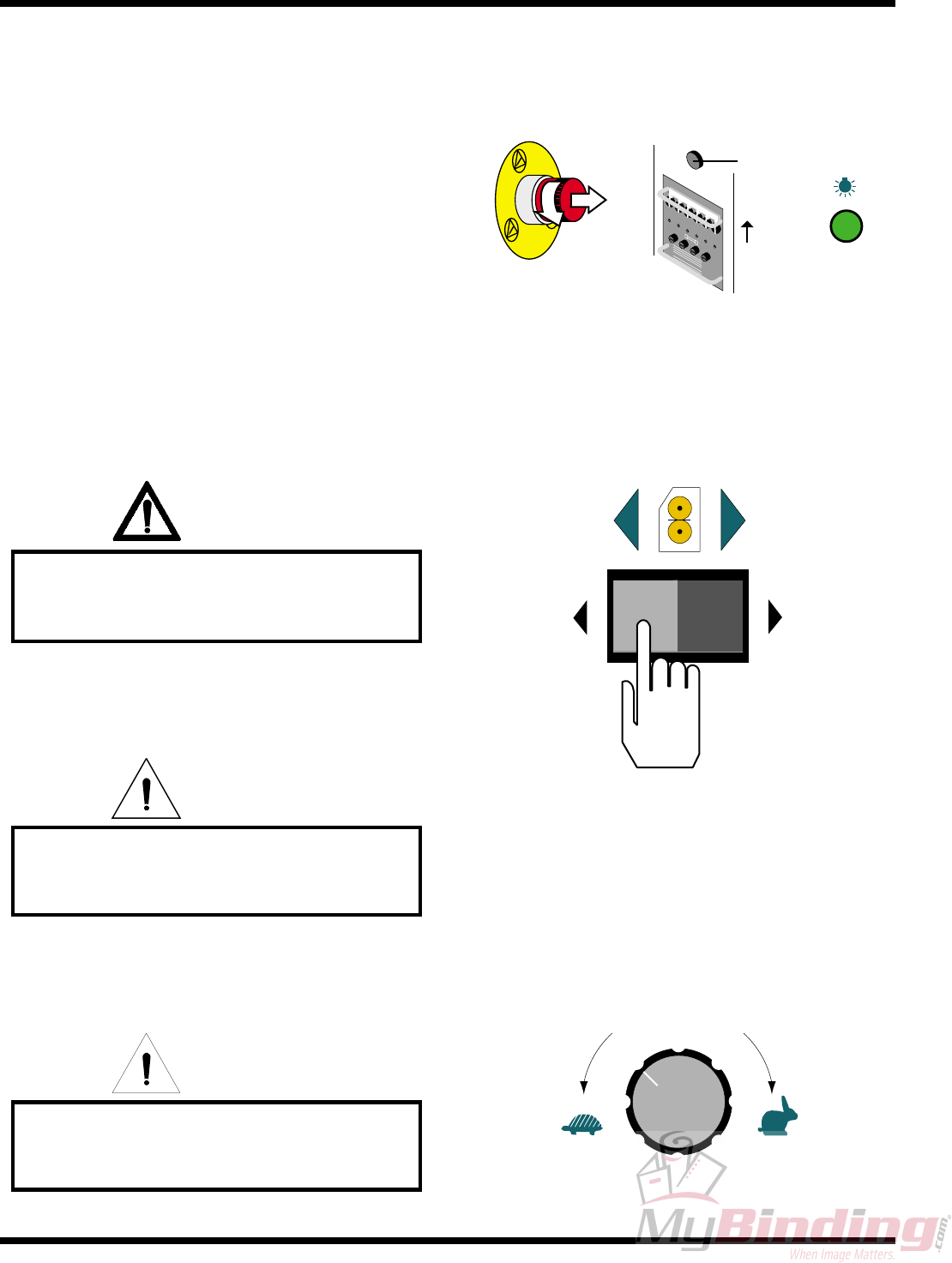
Page 5 - 10
Operations F 60 H Operation and Maintenance Manual
© April 2001 General Binding Corporation
5.7 Setting the nip
Setting the nip is made easy when it comes to
performing a mounting application. Pressure will vary with
regards to the types of substrate being used. An incorrect
nip setting can cause complications with output quality.
For safe nip setting, always adhere to the following
rules listed below.
WARNING
Keep hands and fingers clear of the
laminator roller nip when adjusting nip.
You can be CRUSHED or BURNED!
CAUTION
Excess pressure can damage the laminating
rollers. Always use the minimum roll
pressure necessary to complete the task.
CAUTION
Objects other than media, film or approved
substrates, will cause irreparable damage
to the rollers if caught in the nip.
a) Ensure all E-STOPs are unlatched, power is on
and RESET has been pressed.
1
/
4
tu
r
n
POWER
Reset
On
b) Set the motor direction to REV.
(reverse) (forward)
c) Set a comfortable speed for the application you
are performing.
1
2
3
4567
8
9
10

Page 5 - 11
Operations
F 60 H Operation and Maintenance Manual
© April 2001 General Binding Corporation
CAUTION
Sharp edges on a substrate
should be filed smooth.
Sharp edges can CUT the rollers!
d) Position the substrate center of the feed table
between the two rollers.
PR -TECH
F-60 H
substrate
e) Lower the upper main roller until it makes
contact with the substrate. Lower enough to
apply sufficient pressure without crushing the
substrate.
Excessive pressure will cause the
substrate to bow or flatten.
INFORMATION
Sufficient Excessive
Density of the substrate will determine the
amount of pressure you may use.
INFORMATION
f) Press the motor engage/ disengage to engage or
step on the footswitch to back the board out
from the nip.
(disengage) engage)
f) The nip is now set for the substrate being used.
Remember to set the motor direction to FWD.

Page 5 - 12
Operations F 60 H Operation and Maintenance Manual
© April 2001 General Binding Corporation
5.8 Footswitch
WARNING
When operating the laminator using the
footswitch, keep hands and fingers
away from the nip of the rollers.
You may be CRUSHED or BURNED!
The footswitch operates differently based on the
motor direction setting.
Forward
a) Press the motor direction to FWD.
(reverse) (forward)
b) Set your speed dial to a comfortable operating
speed.
1
2
3
4567
8
9
10
WARNING
The variable speed footswitch over-rides
the PHOTO-EYE safety circuit !
c) When the footswitch is pressed, roller speed is
dependent on what you have selected on the
speed dial.
d) You may adjust speed while the footswitch is
depressed.
Reverse
a) Press the motor direction to REV.
b) Press on the footswitch. The footswitch speed is
limited to 1 foot per minute ( 30 cm/ minute )
regardless of motor speed dial setting..

Page 6 - 1
ApplicationsF 60 H Operation and Maintenance Manual
© April 2001 General Binding Corporation
6.0 Applications
The Falcon 60 H can accommodate Poly-in or
Poly-out films. Poly-out means the adhesive is on the
outside of the roll.
The shiny side of clear film must contact the main
rollers with the dull sides ( adhesive side ) facing out. Use
caution when loading matte or de-luster film since both
sides appear dull.
The top and bottom rolls of laminating film must
be of the same width and be present simultaneously. If
performing a single sided lamination process, a craft paper
carrier or a substrate of the same width must be used in
place of the bottom laminate.
WARNING
Do not wear ties, loose fit clothing or
dangling jewelry while operating or
servicing the laminator. These items can get
caught in the nip and choke you or you can
be crushed or burned.
The process control charts and web diagrams
illustrated in this section are reference points only.
Parameters will vary with regards to laminate
thickness, laminate widths, laminate types, print
types, ink or toner types, paper types, environment
conditions and operator experience.
6.1 Helpful hints
Pressure sensitive materials
In most cases, a little heat ( 120 oF / 49 oC ) helps
the adhesive in pressure sensitive films flow smoothly to
prevent what we call “silvering” in the laminate.
The release liner on pressure sensitive films should
separate just above the main roller.
Use film brake tension to control the
separation point of the release liner.
INFORMATION
Lo-Melt film materials
Most Lo-Melt adhesives activate around 180OF
~ 200OF ( 82OC ~ 93OC ) which is below the boiling
point for water based inks. For thicker Lo-Melt films,
adjust the speed to allow for a longer dwell time in the
nip.
Speeds and temperatures will affect the
bond strength of Lo-Melt adhesives.
INFORMATION

Page 6 - 2 © April 2001 General Binding Corporation
Applications F 60 H Operation and Maintenance Manual
Mounting
Mounting on the Falcon 60 H is achieved from
the front operating position. Heat can also assist with
mounting, it follows the same hints as pressure sensitive
materials.
The mount adhesive must not exceed 1 in.
the width of the substrate. If it does, you
will experience complications with this
application.
INFORMATION
Pressure
Most lamination is performed at 50 ~ 70% of
pressure on the rollers. Once again, there are variables
that may require some adjustments of the above mentioned
pressures.
Typically the thicker the paper, the more pressure
required and for thinner paper ( tissue paper/ light bond
paper ) you can use less pressure ( as little as 50 % ) on
the roller.
When it comes to mounting, the one general “rule”
is to not crush the substrate. Most substrates only require
about 20-50 % of pressure, but variables can effect how
much pressure is actually needed. ( width, thickness,
density, etc. )
Excessive pressure will cause the
substrate to bow or flatten.
INFORMATION
Brake tension
Brake tension should always be minimal. Brake
tension should always be even from the top roll of film
to the lower roll of film. Never use excessive amount of
brake tension.
Excessive brake tension may cause the
image to curl. Always use the minimum
amount of brake for the job.
INFORMATION
General
CAUTION
Excess pressure can damage the laminating
rollers. Always use the minimum roll
pressure necessary to complete the task.
Never stop the laminator when an image is
within the nip of the rollers.
INFORMATION
Laminates and papers should always be
stored in a controlled enviroment.
INFORMATION

Page 6 - 3
ApplicationsF 60 H Operation and Maintenance Manual
© April 2001 General Binding Corporation
6.2 Temp conversion chart
A temperature conversion chart has been included for your convenience. Use the chart below for converting
temperatures from oF to oC and vice a versa.
Figure 6.2.1 Temperature conversion chart
o F o C
o F o C
o F o C
o F o C
68 20
=
69 20.6
=
70 21.1
=
71 21.7
=
72 22.2
=
73 22.7
=
74 23.3
=
75 23.9
=
76 24.4
=
77 25
=
78 25.6
=
79 26.1
=
80 26.7
=
81 27.2
=
82 27.8
=
83 28.3
=
84 28.9
=
85 29.4
=
86 30
=
87 30.6
=
88 31.1
=
89 31.7
=
90 32.2
=
91 32.8
=
92 33.3
=
93 33.9
=
94 34.4
=
95 35
=
96 35.6
=
97 36.1
=
98 36.7
=
99 37.2
=
100 37.8
=
101 38.3
=
102 38.9
=
103 39.4
=
104 40
=
105 40.6
=
106 41.1
=
107 41.7
=
108 42.2
=
109 42.8
=
110 43.3
=
111 43.9
=
113 45
=
114 45.6
=
115 46.1
=
116 46.7
=
117 47.2
=
118 47.8
=
119 48.3
=
120 48.9
=
121 49.4
=
122 50
=
123 50.6
=
124 51.1
=
125 51.7
=
126 52.2
=
127 52.8
=
128 53.3
=
129 53.9
=
130 54.4
=
131 55
=
132 55.6
=
133 56.1
=
134 56.7
=
135 57.2
=
112 44.4
=
136 57.8
=
137 58.3
=
138 58.9
=
139 59.4
=
140 60
=
141 60.6
=
142 61.1
=
143 61.7
=
144 62.2
=
145 62.8
=
146 63.3
=
147 63.9
=
148 64.4
=
149 65
=
150 65.6
=
151 66.1
=
152 66.7
=
153 67.2
=
154 67.8
=
155 68.3
=
158 70
=
159 70.6
=
160 71.1
=
161 71.7
=
162 72.2
=
163 72.8
=
164 73.3
=
165 73.9
=
166 74.4
=
167 75
=
168 75.6
=
169 76.1
=
156 68.9
=
157 69.4
=
170 76.7
=
171 77.2
=
172 77.8
=
173 78.3
=
174 78.9
=
175 79.4
=
176 80
=
177 80.6
=
178 81.1
=
179 81.7
=
180 82.2
=
181 82.8
=
182 83.3
=
183 83.9
=
184 84.4
=
185 85
=
186 85.6
=
187 86.1
=
188 86.7
=
189 87.2
=
190 87.8
=
191 88.3
=
192 88.9
=
193 89.4
=
194 90
=
195 90.6
=
196 91.1
=
197 91.7
=
198 92.2
=
199 92.8
=
200 93.3
=

Page 6 - 4 © April 2001 General Binding Corporation
Applications F 60 H Operation and Maintenance Manual
This page intentionally left blank.

Page 6 - 5
ApplicationsF 60 H Operation and Maintenance Manual
© April 2001 General Binding Corporation
6.3 Charts and diagrams
Process control charts allow you to record the
way you thread film through the machine’s rollers and idlers
(called webbing) and the control settings for each prod-
uct and process. Process control charts are an excellent
tool for training new operators. They provide a “road
map” for correct machine setup and operation.
This section contains a blank process control chart
and diagram for the Falcon 60 H as well as completed
charts for the basic operations of the laminator. The pro-
cess control charts should be kept in this manual or in a
book close to the laminator.
The Falcon 60 H laminator responds in a very
accurate and repeatable manner. The charts provide a
way to set up each time, every time for repeatable per-
formance by assuring that all controls are set to optimum.
The completed process control charts included
in this section are based on GBC films, GBC boards and
typical prints. Charts and diagrams start on page 6-6. If
your machine is equipped with the roll to roll option, web-
bing diagrams for related applications are aslo incleded.

Page 6 - 6 © April 2001 General Binding Corporation
Applications F 60 H Operation and Maintenance Manual
PROCESS CONTROL CHART
Materials -
Top material :
Bottom material :
Other material (s) :
CAL 3200
CAL 3200
Motor Direction
Motor Speed
1
2
3
4567
8
9
10
Roller Pressure
Upper Roller Temperature
Heater
RANGE
Notes :
RANGE

Page 6 - 7
ApplicationsF 60 H Operation and Maintenance Manual
© April 2001 General Binding Corporation
Diagram - Blank

Page 6 - 8 © April 2001 General Binding Corporation
Applications F 60 H Operation and Maintenance Manual
This page intentionally left blank.

Page 6 - 9
ApplicationsF 60 H Operation and Maintenance Manual
© April 2001 General Binding Corporation
Diagram - Blank w/ roll to roll options

Page 6 - 10 © April 2001 General Binding Corporation
Applications F 60 H Operation and Maintenance Manual
PROCESS CONTROL CHART
Materials - Pre-coating substrates
Top material : Roll of pressure sensitive mount adhesive
Bottom material : N/A
Other material (s) : Substrates, leader board and trailer board
CAL 3200
CAL 3200
Motor Direction
Motor Speed
1
2
3
4567
8
9
10
range
Roller Pressure
Upper Roller Temperature
Heater
RANGE
Notes : The roll of mount adhesive should not exceed the substrate by more than 1 in.
(2.5 cm). Speed will be determined by what is comfortable with the operator. Pressure
is dependent on the substrate. Do not crush the substrate. Use a leader board to start
the run and stop the run when the trailer board is in the nip of the rollers. Stopping on
a subtsrate will leave an impression on the board. Refer to helpful hints for pressure
sensitive materials and mounting.
RANGE
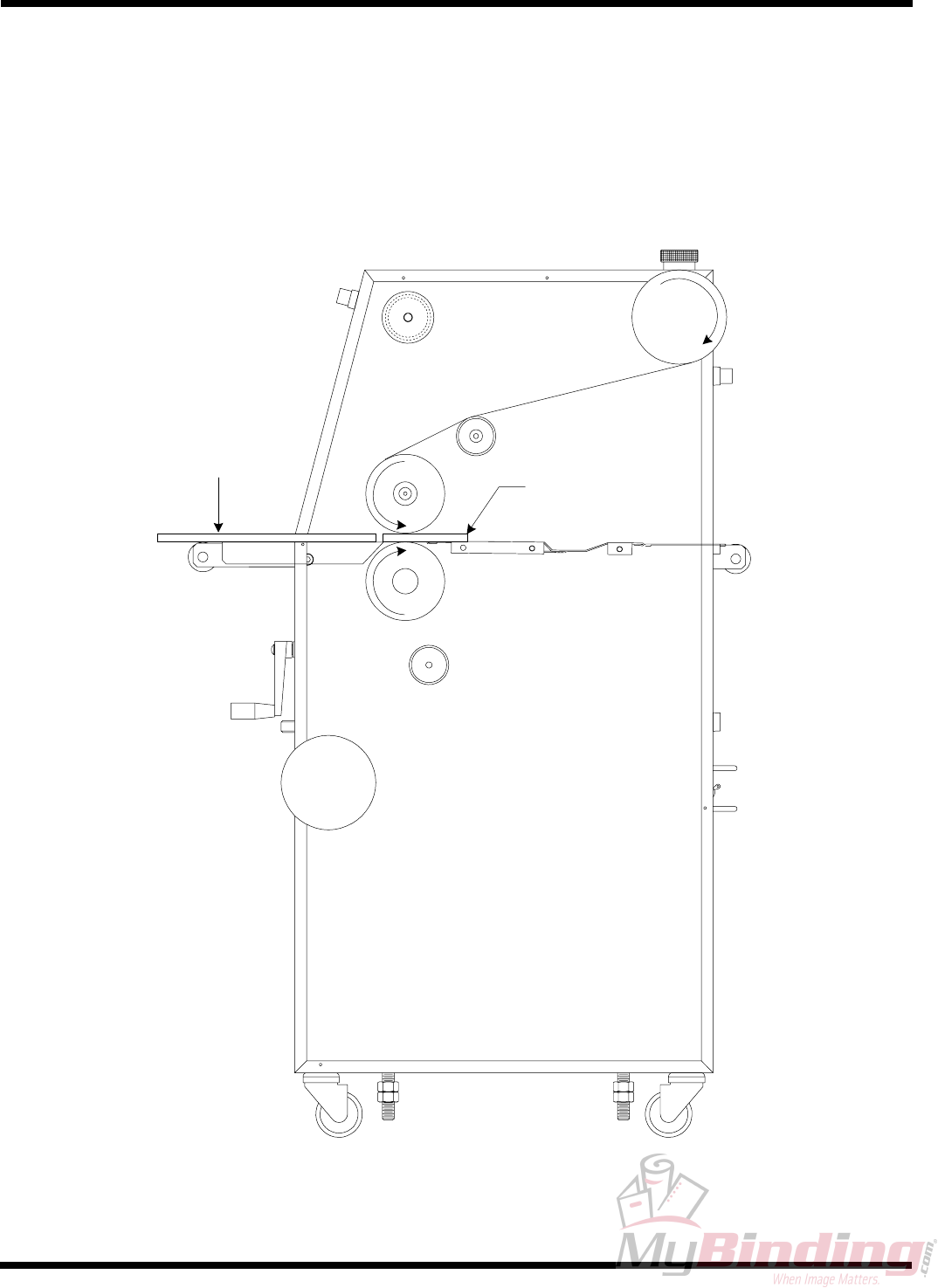
Page 6 - 11
ApplicationsF 60 H Operation and Maintenance Manual
© April 2001 General Binding Corporation
Diagram - Pre-coating substrates
Roll of
mount
adhesive
Leader board
Substrate

Page 6 - 12 © April 2001 General Binding Corporation
Applications F 60 H Operation and Maintenance Manual
PROCESS CONTROL CHART
Materials - Mounting an image
Top material : N/A
Bottom material : N/A
Other material (s) : Image and a Pre-coated board
CAL 3200
CAL 3200
Motor Direction
Motor Speed
Roller Pressure
Upper Roller Temperature
Heater
RANGE
Notes: The image shoud not exceed the pre-coated board by more than 1 in. ( 2.5 cm ). If
the image is smaller than the precoated board, trim the board or pre-trim the release liner
around the image. Speed for mounting should be comfortable for the operator. Use the
footswitch for this application. Pressure will be dependent on the type of subtrate. No
heat is required for this application. Do not crush the substrate. Do not stop in the middle
of the run. Refer to helpful hints for mounting.
RANGE
1
2
3
4567
8
9
10
range
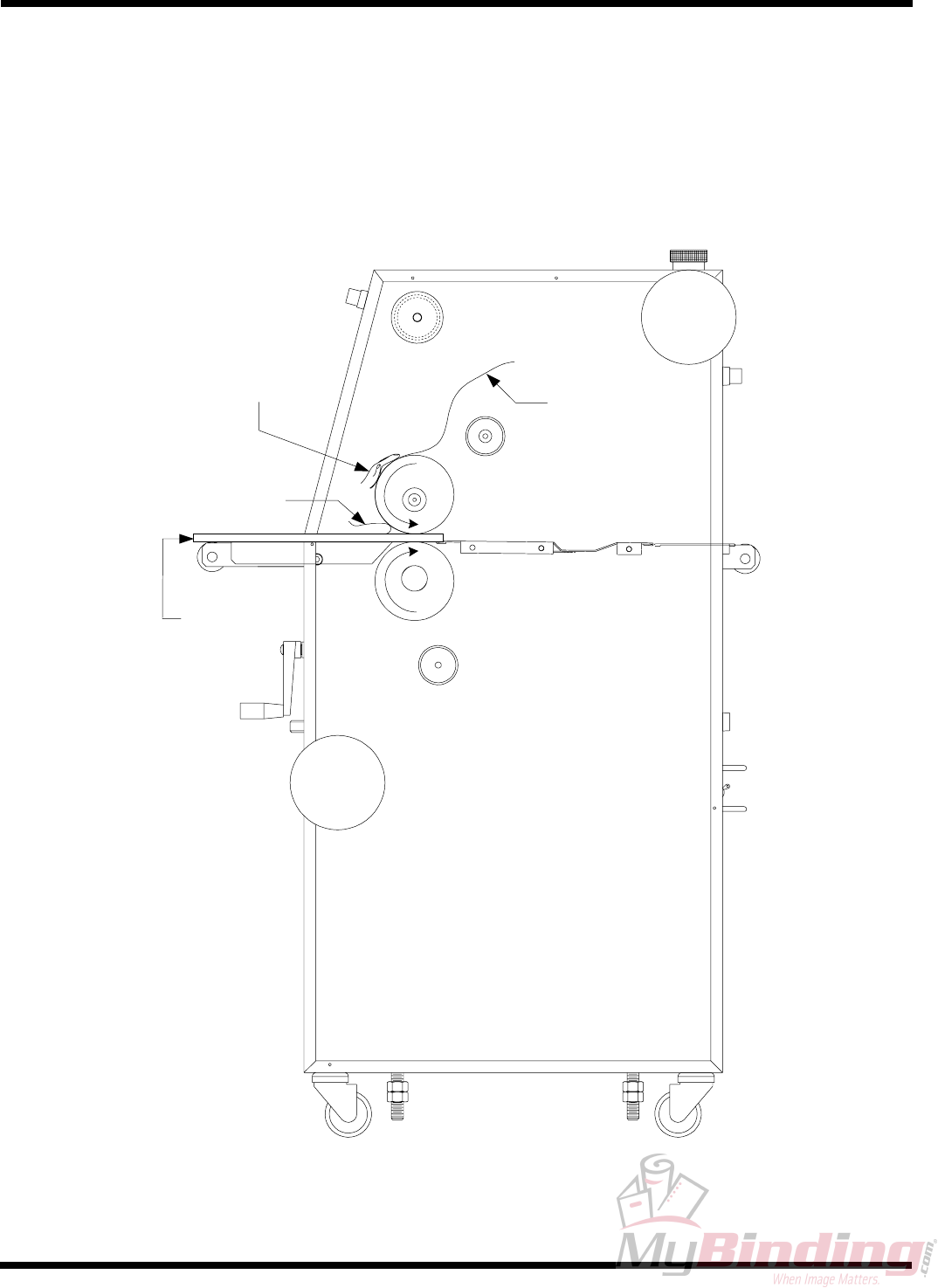
Page 6 - 13
ApplicationsF 60 H Operation and Maintenance Manual
© April 2001 General Binding Corporation
Diagram - Mounting an image
Pre-coated
board
Liner
Image
Hold image here
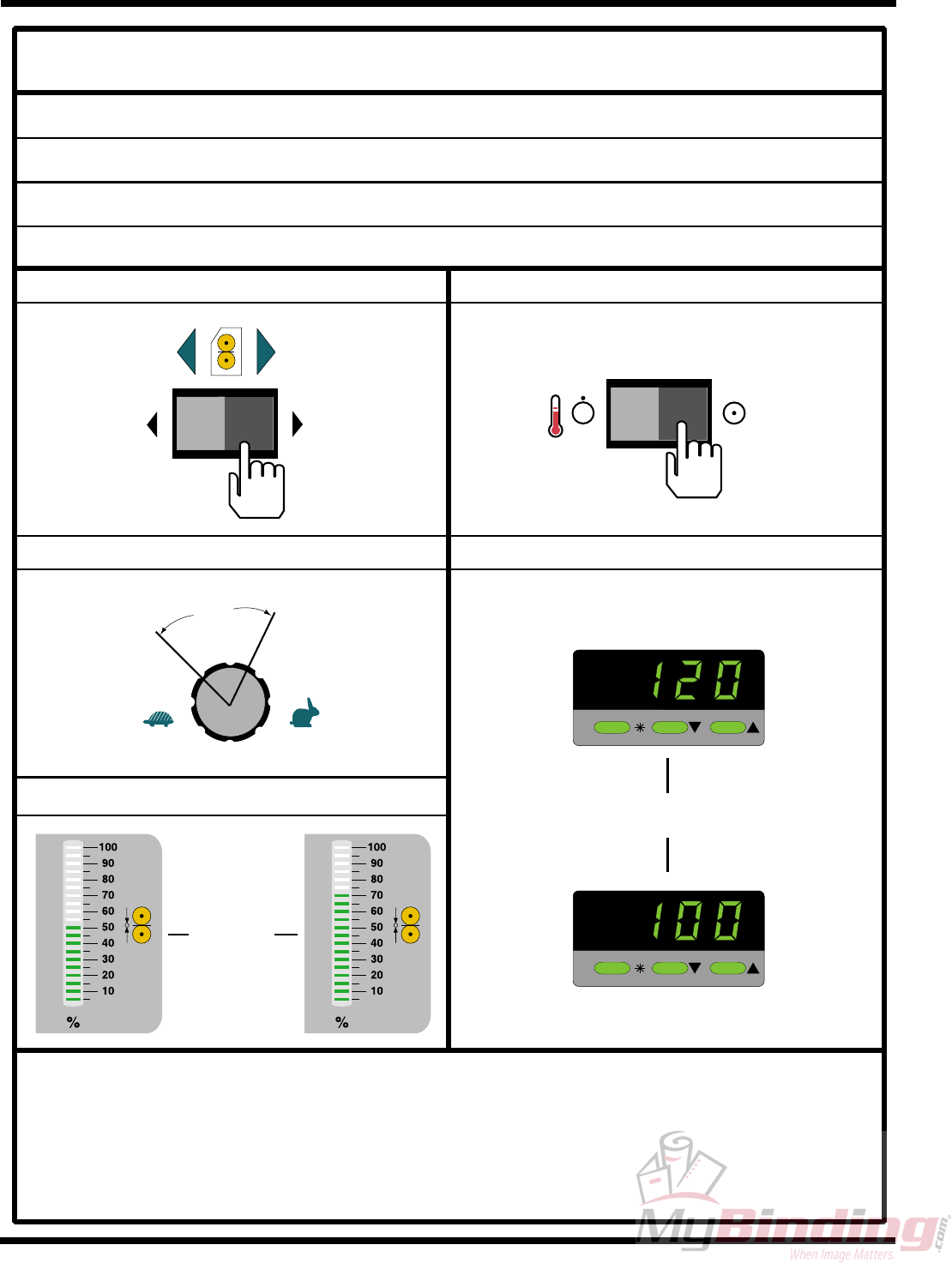
Page 6 - 14 © April 2001 General Binding Corporation
Applications F 60 H Operation and Maintenance Manual
CAL 3200
CAL 3200
PROCESS CONTROL CHART
Materials - PSA Decaling
Top material : Roll of pressure sensitive laminate
Bottom material : Roll of pressure sensitive mount adhesive
Other material (s) : prints
Motor Direction
Motor Speed
1
2
3
4567
8
9
10
range
Roller Pressure
Upper Roller Temperature
Heater
RANGE
Notes: Speed should be comfortable for the operator. Pressure will vary depending on the
weight and width of the image and laminate. Heat is optional. Some will assist the flow of
the adhesive in pressure sensitive films. Refer to helpful hints for pressure sensitive films.
RANGE

Page 6 - 15
ApplicationsF 60 H Operation and Maintenance Manual
© April 2001 General Binding Corporation
Diagram - PSA decaling
Image
Decal
Roll of
PSA film
Roll of
mount
adhesive
Release liner

Page 6 - 16 © April 2001 General Binding Corporation
Applications F 60 H Operation and Maintenance Manual
This page intentionally left blank.
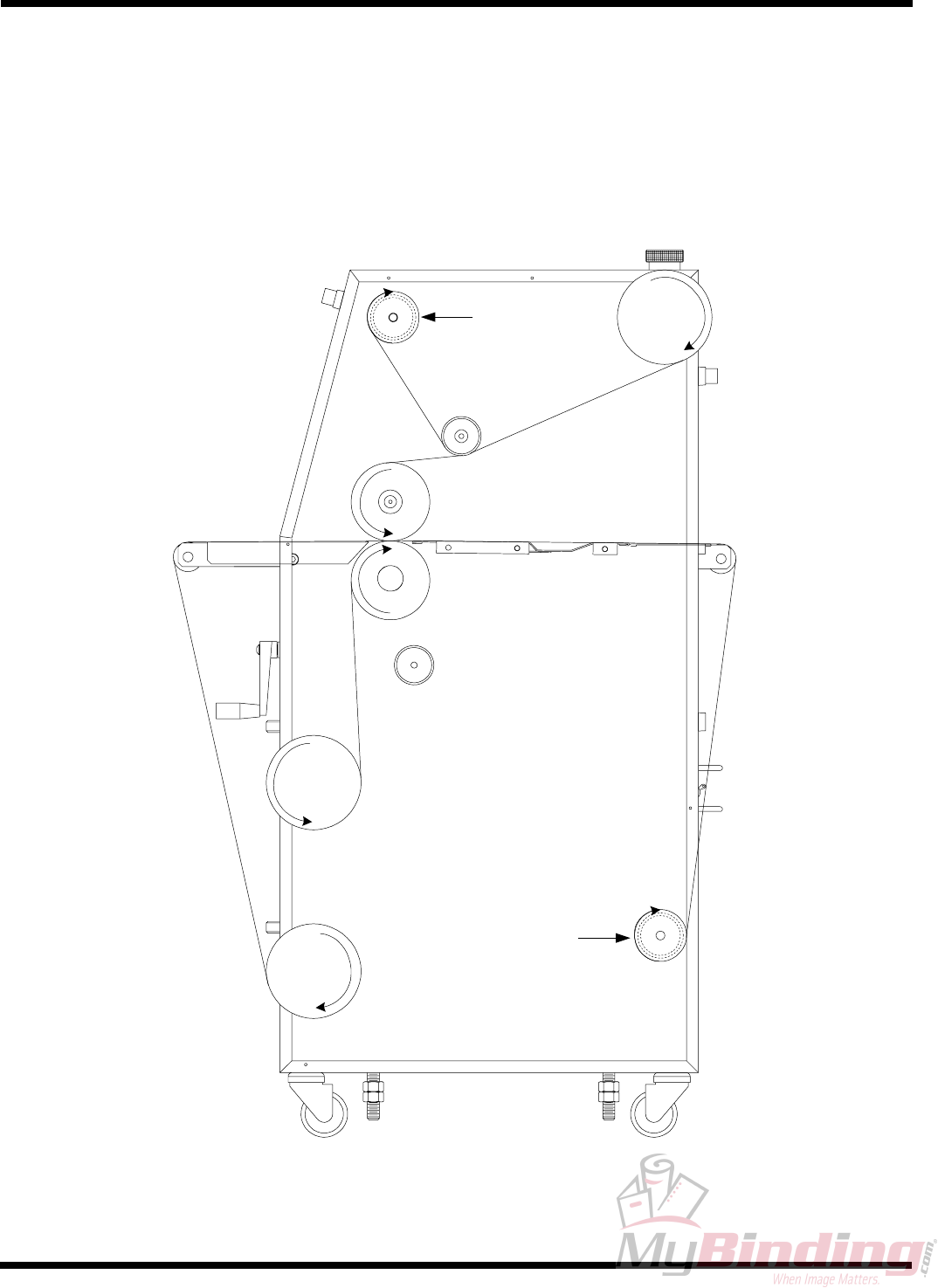
Page 6 - 17
ApplicationsF 60 H Operation and Maintenance Manual
© April 2001 General Binding Corporation
Roll of
PSA film
Roll of
mount
adhesive
Release liner
Roll of
prints
Rewind of decals
Diagram - PSA decaling w/ roll to roll options

Page 6 - 18 © April 2001 General Binding Corporation
Applications F 60 H Operation and Maintenance Manual
PROCESS CONTROL CHART
Materials - Lo-Melt Decaling
Top material : Roll of Lo-Melt film
Bottom material : Roll of pressure sensitive adhesive
Other material (s) : prints
CAL 3200
CAL 3200
Motor Direction
Motor Speed
1
2
3
4567
8
9
10
range
Roller Pressure
Upper Roller Temperature
Heater
RANGE
Notes : Speed will be dependent on the activation of the Lo-Melt adhesive. If the output
appears cloudy or milky, reduce the speed. Pressure will vary depending on the weight
and width of the image and laminate. For thinner laminates, use the 180 oF ( 82 oC ) and
for thicker films, use the 200 oF ( 93 oC ).
RANGE

Page 6 - 19
ApplicationsF 60 H Operation and Maintenance Manual
© April 2001 General Binding Corporation
Diagram - Lo-Melt decaling
Image
Decal
Roll of
Lo-Melt
film
Roll of
mount
adhesive

Page 6 - 20 © April 2001 General Binding Corporation
Applications F 60 H Operation and Maintenance Manual
This page intentionally left blank.

Page 6 - 21
ApplicationsF 60 H Operation and Maintenance Manual
© April 2001 General Binding Corporation
Diagram - Lo-Melt decaling w/ roll to roll options
Roll of
Lo-Melt
film
Roll of
mount
adhesive
Roll of
prints
Rewind of decals
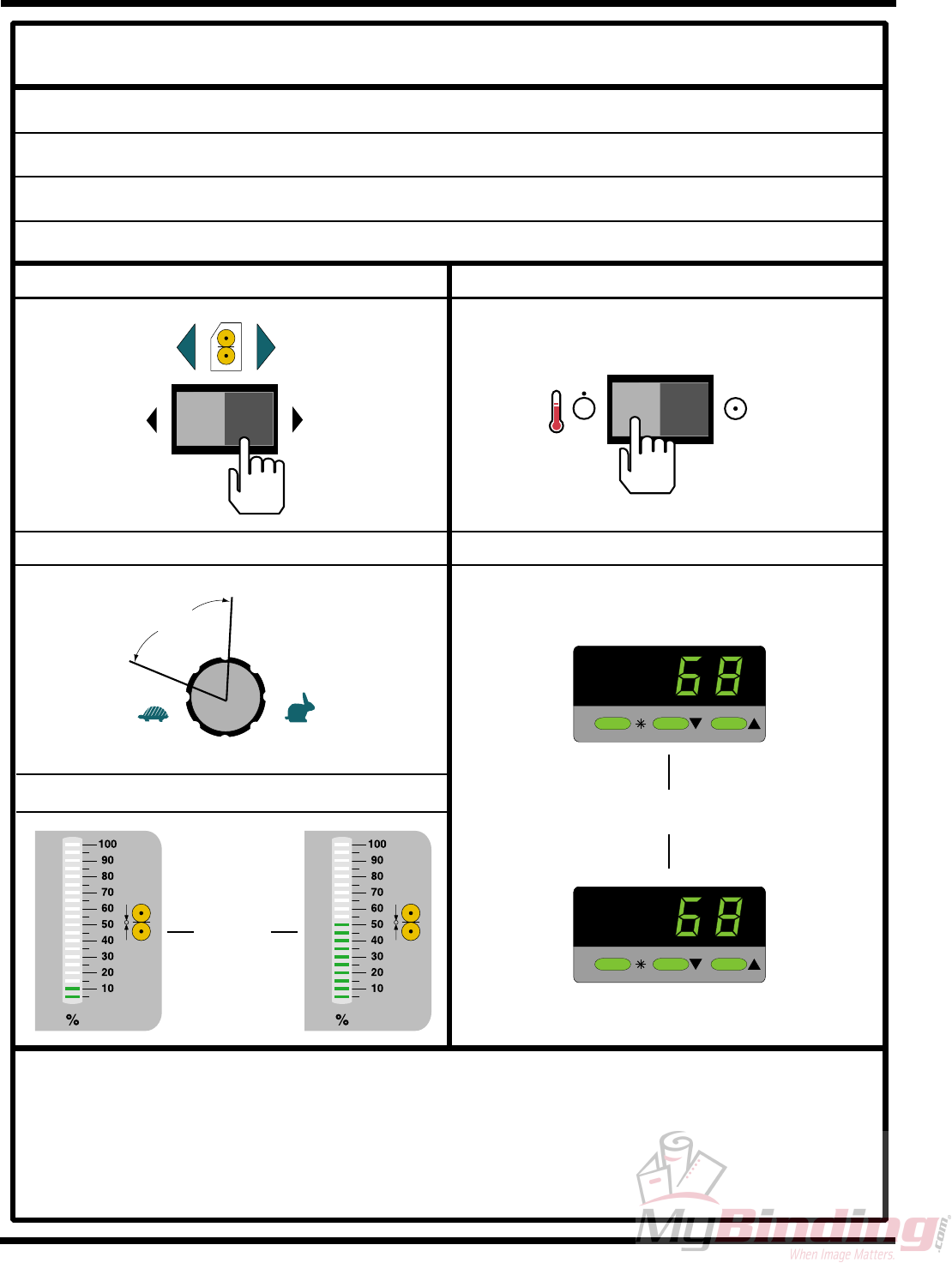
Page 6 - 22 © April 2001 General Binding Corporation
Applications F 60 H Operation and Maintenance Manual
PROCESS CONTROL CHART
Materials - Mounting a decal
Top material : N/A
Bottom material : N/A
Other material (s) : Decal and substrate
CAL 3200
CAL 3200
Motor Direction
Motor Speed
Roller Pressure
Upper Roller Temperature
Heater
RANGE
Notes: Speed for mounting should be comfortable for the operator. Use the footswitch
for this application. Pressure will be dependent on the type of subtrate. No heat is
required for this application. Do not crush the substrate. Do not stop in the middle of
the run. Refer to helpful hints for mounting.
RANGE
1
2
3
4567
8
9
10
range

Page 6 - 23
ApplicationsF 60 H Operation and Maintenance Manual
© April 2001 General Binding Corporation
Diagram - Mounting a decal
Substrate
Liner
Decal
Hold decal here
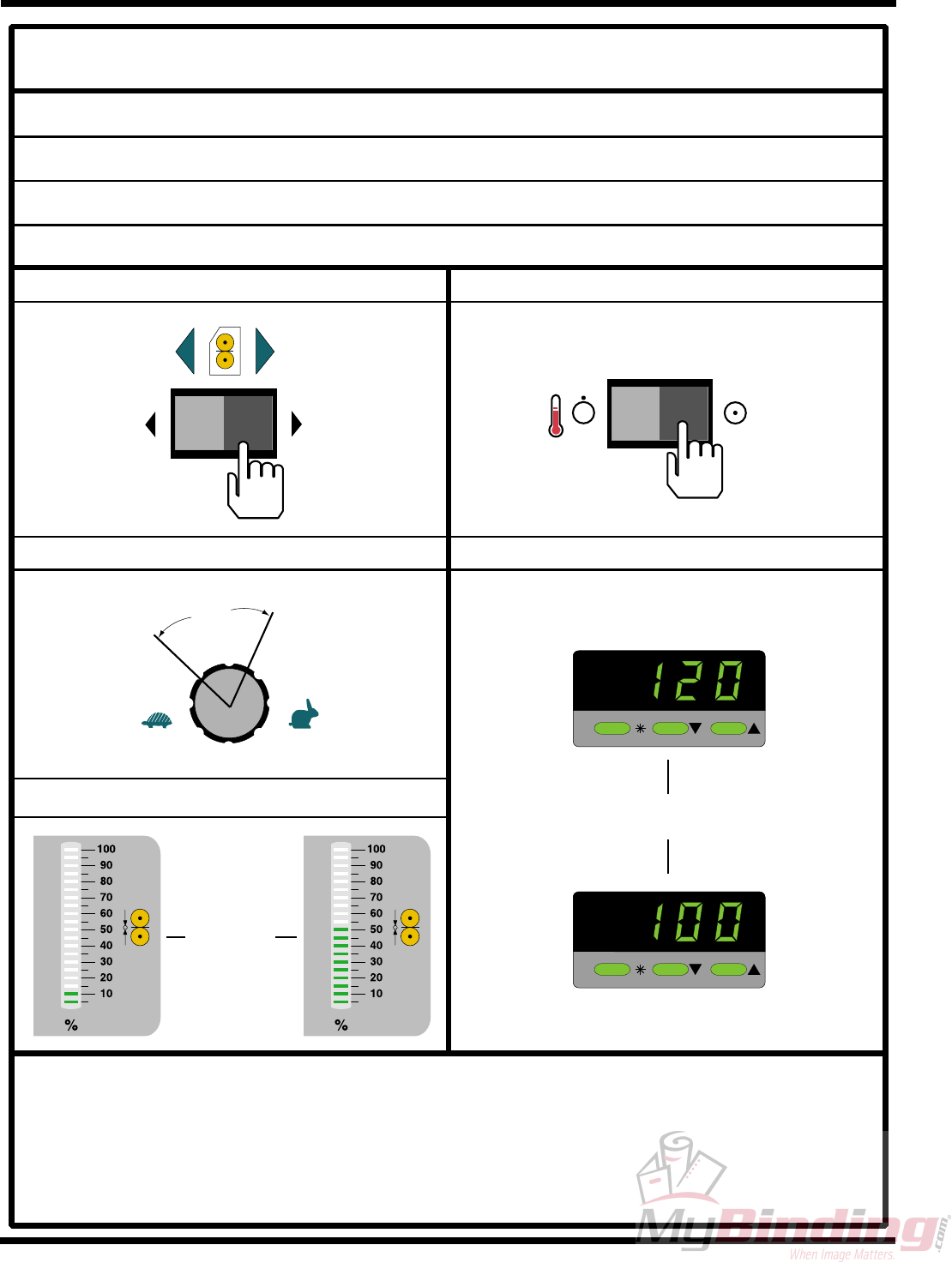
Page 6 - 24 © April 2001 General Binding Corporation
Applications F 60 H Operation and Maintenance Manual
PROCESS CONTROL CHART
Materials - PSA Single sided lamination ( sled method)
Top material : Roll of pressure sensitive laminate
Bottom material : N/A
Other material (s) : Images, leader board, trailer board and a pre-coated board
CAL 3200
CAL 3200
Motor Direction
Motor Speed
1
2
3
4567
8
9
10
range
Roller Pressure
Upper Roller Temperature
Heater
RANGE
Notes : The leader board and trailer board should be the same width as the pre-coated
board. The laminate should not exceed the pre-coated board by more than 1 in. ( 2.54 cm ).
Do not use excessive brake tension for this application. Pre-coated board is reusable
since the laminate does not bond with the release liner from the pressure sensitive
adhesive. Speed should be comfortable for the operator. Pressure will vary depending on
the type of substrate. Heat is optional. Some heat will assist the flow of adhesive. Refer to
helpful hints for pressure sensitive films.
RANGE

Page 6 - 25
ApplicationsF 60 H Operation and Maintenance Manual
© April 2001 General Binding Corporation
Pre-coated
board
Roll of
PSA film
Release liner
Leader board
Image
Diagram - PSA single sided lamination
( sled method )
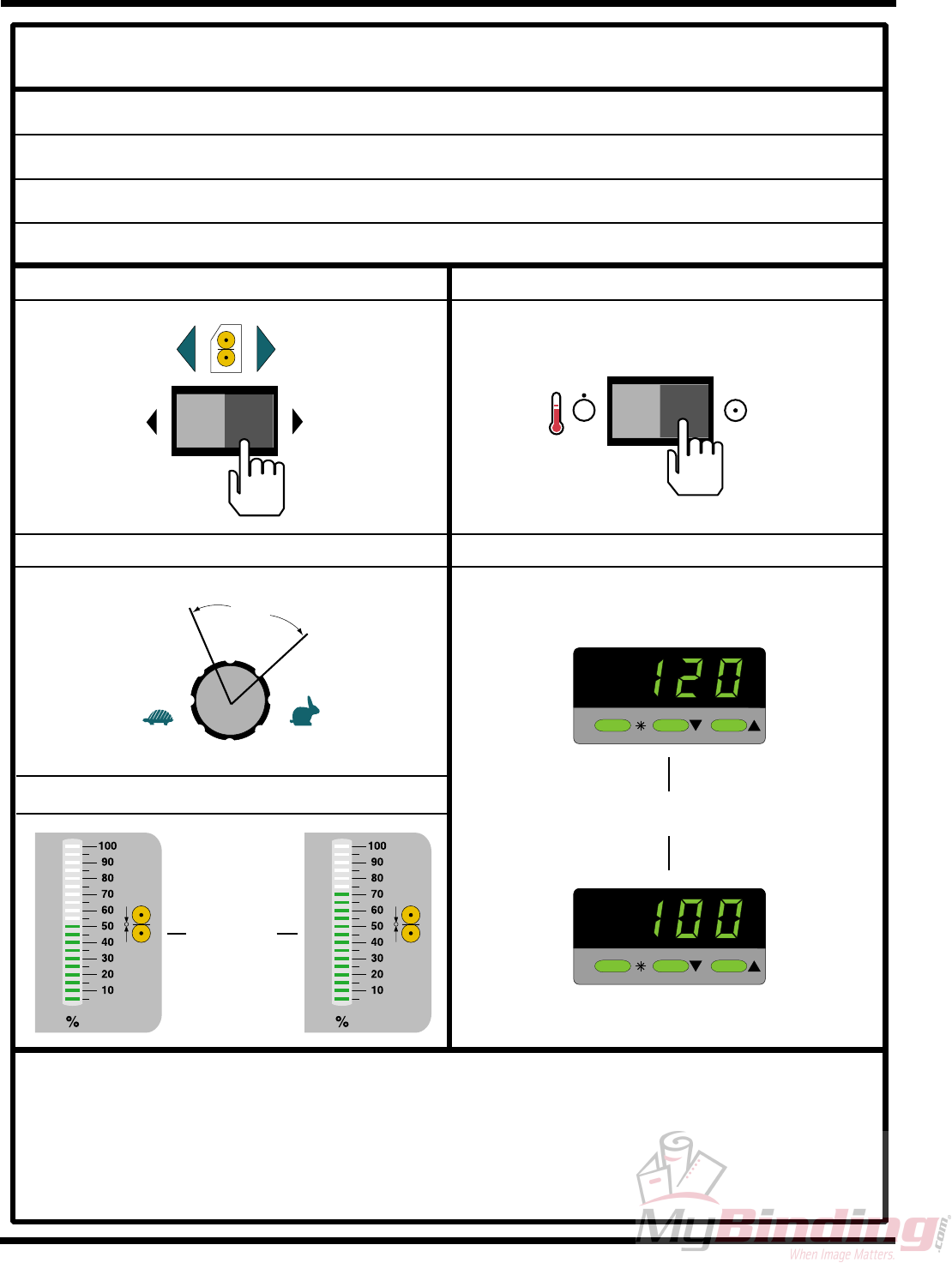
Page 6 - 26 © April 2001 General Binding Corporation
Applications F 60 H Operation and Maintenance Manual
PROCESS CONTROL CHART
Materials - PSA Single sided lamination ( craft paper method)
Top material : Roll of pressure sensitive laminate
Bottom material : Roll of craft paper
Other material (s) : Prints
CAL 3200
CAL 3200
Motor Direction
Motor Speed
1
2
3
4567
8
9
10
range
Roller Pressure
Upper Roller Temperature
Heater
RANGE
Notes: Top and bottom material should be of the same width. Do not use excessive brake
tension for this application. Speed should be comfortable for the operator. Pressure will
vary depending on the width and weight of the image and laminate. Heat is optional.
Some heat will assist the flow of adhesive. Refer to helpful hints for pressure sensitive
films.
RANGE
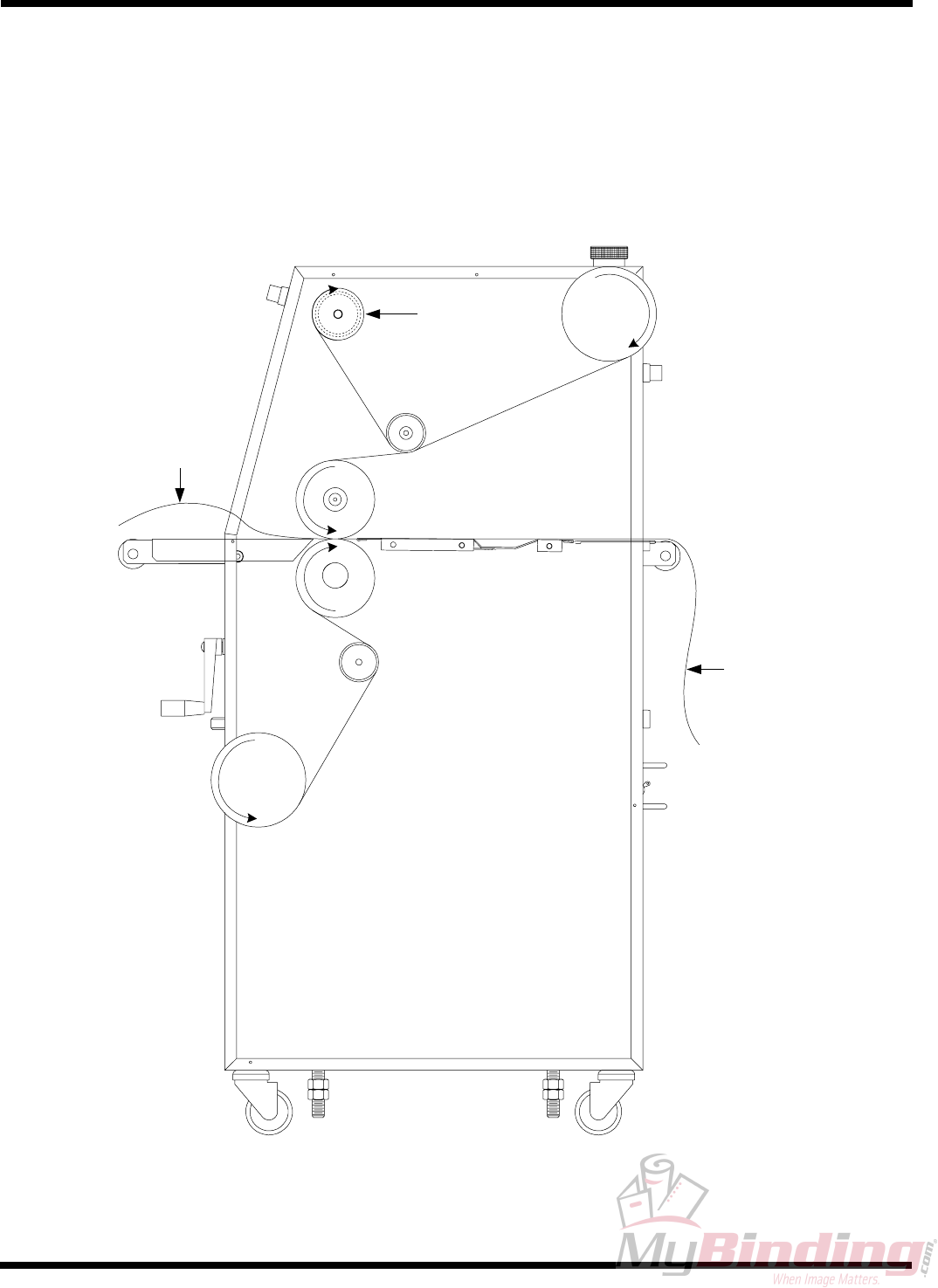
Page 6 - 27
ApplicationsF 60 H Operation and Maintenance Manual
© April 2001 General Binding Corporation
Diagram - PSA single sided lamination
( craft paper method )
Image
Finished
product
Roll of
PSA film
Roll of
craft
paper
Release liner

Page 6 - 28 © April 2001 General Binding Corporation
Applications F 60 H Operation and Maintenance Manual
This page intentionally left blank.
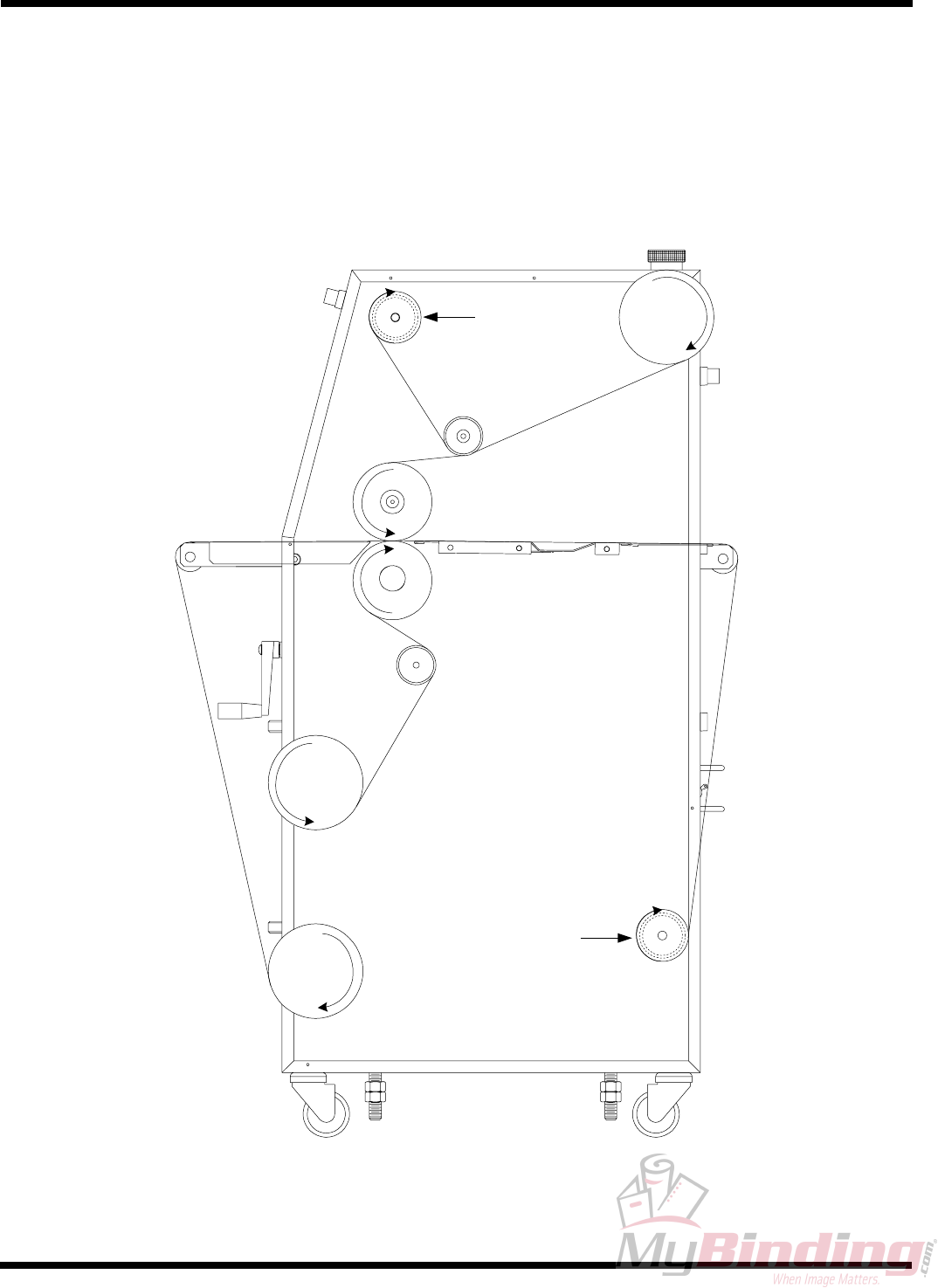
Page 6 - 29
ApplicationsF 60 H Operation and Maintenance Manual
© April 2001 General Binding Corporation
Diagram - PSA single sided lamination
( craft paper method w/ roll to roll option )
Roll of
PSA film
Roll of
craft
paper
Release liner
Roll of
prints
Rewind of
finished product

Page 6 - 30 © April 2001 General Binding Corporation
Applications F 60 H Operation and Maintenance Manual
PROCESS CONTROL CHART
Materials - PSA over-lamination of a mounted image
Top material : Roll of pressure sensitive laminate
Bottom material : N/A
Other material (s) : A pre-mounted image to a board, leader board and trailer board
CAL 3200
CAL 3200
Motor Direction
Motor Speed
1
2
3
4567
8
9
10
range
Roller Pressure
Upper Roller Temperature
Heater
RANGE
Notes : The laminate should not exceed the pre-mounted image by more than 3 in. (7.6 cm).
Speed will be determined by what is comfortable with the operator. Pressure is dependent
on the substrate. Do not crush the substrate. Use a leader board to start the process and
finish with a trailer board. Stopping on the image will aleave an impression on the board
or image. Heat is optional. Refer to helpful hints for pressure sensitive materials and
mountng.
RANGE

Page 6 - 31
ApplicationsF 60 H Operation and Maintenance Manual
© April 2001 General Binding Corporation
Diagram - PSA over-lamination of a mounted image
Mounted image
Roll of
PSA film
Release liner
Leader board
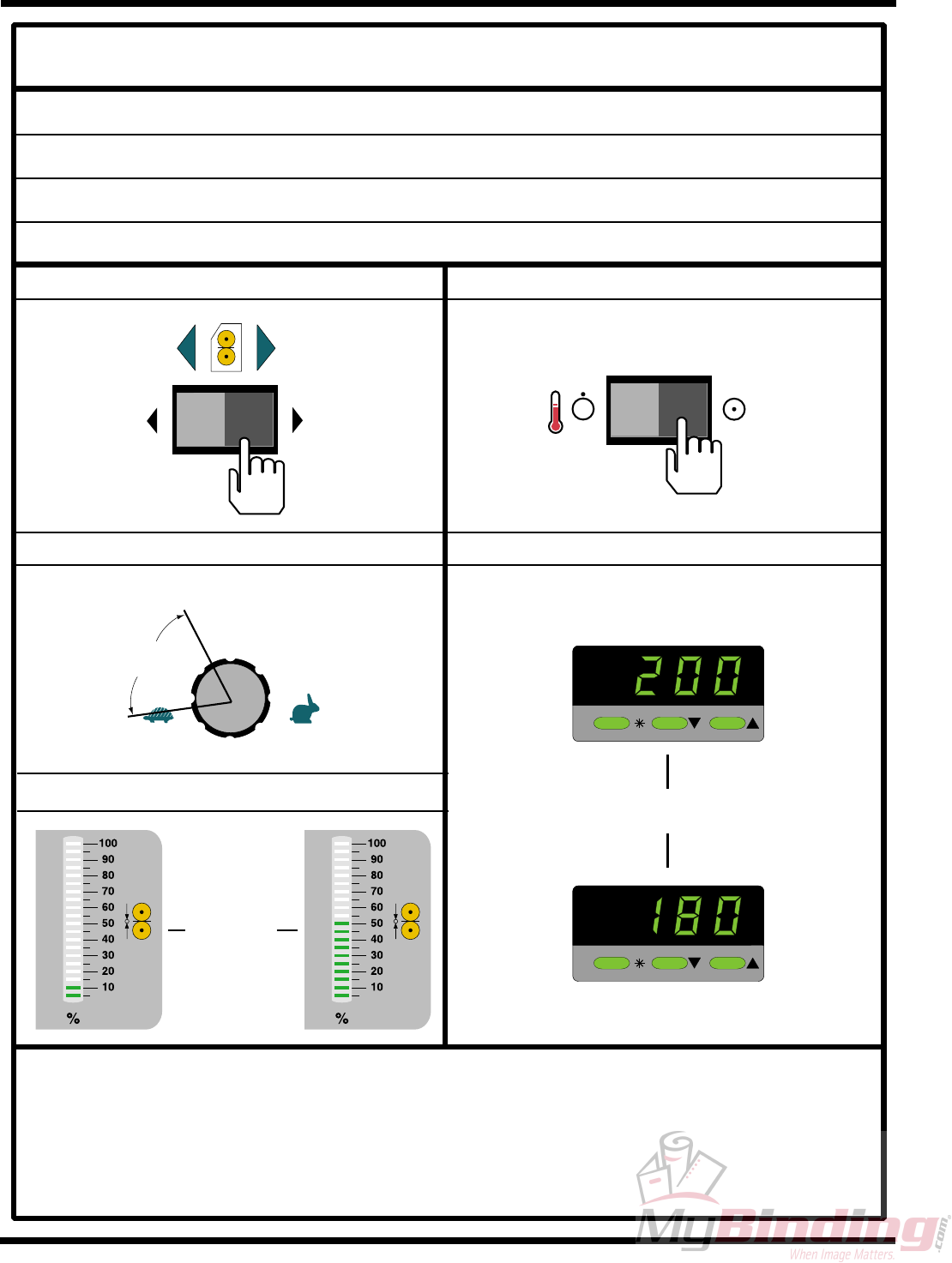
Page 6 - 32 © April 2001 General Binding Corporation
Applications F 60 H Operation and Maintenance Manual
PROCESS CONTROL CHART
Materials - Lo-Melt over-lamination of a mounted image
Top material : Roll of Lo-Melt film
Bottom material : N/A
Other material (s) : A pre-mounted image to a board, leader board and trailer board
CAL 3200
CAL 3200
Motor Direction
Motor Speed
1
2
3
4567
8
9
10
range
Roller Pressure
Upper Roller Temperature
Heater
RANGE
Notes : The laminate should not exceed the pre-mounted image by more than 3 in. (7.6 cm).
Speed will be determined by what is comfortable with the operator. Pressure is dependent
on the substrate. Do not crush the substrate. Use a leader board to start the process and
finish with a trailer board. Stopping on the image will aleave an impression on the board
or image. Heat is dependent on the thickness of the film. Refer to helpful hints for Lo-Melt
films and mountng.
RANGE

Page 6 - 33
ApplicationsF 60 H Operation and Maintenance Manual
© April 2001 General Binding Corporation
Diagram - Lo-Melt over-lamination of a mounted image
Mounted image
Roll of
Lo-Melt
film
Leader board

Page 6 - 34 © April 2001 General Binding Corporation
Applications F 60 H Operation and Maintenance Manual
This page intentionally left blank.

Page 7 - 1
TroubleshootingF 60 H Operation and Maintenance Manual
© April 2001 General Binding Corporation
7.0 Troubleshooting
WARNING
Do not wear ties, loose fitting clothing or
dangling jewelry while operating or
servicing the laminator. These items can get
caught in the nip and choke you or you can
be crushed or burned.
As an operator, you can perform some simple
troubleshooting in attempt to correct your typical output
type problems. Use the easy to follow guide for assistance.
7.1 Wave problems
The following is a list of common output wave
problems you may encounter.
The arrow along the length of the output
represents the direction of feed ( travel ).
INFORMATION
For optimal temperature settings of
various laminates, contact your
supplier or sales representative.
Problem: D waves in the image but not in the laminate
Hints: • Check paper tension
• Check relative moisture content of the paper
Problem: D Waves in the laminate
Hints: • Check the roll pressure
• Check the main roll nip settings
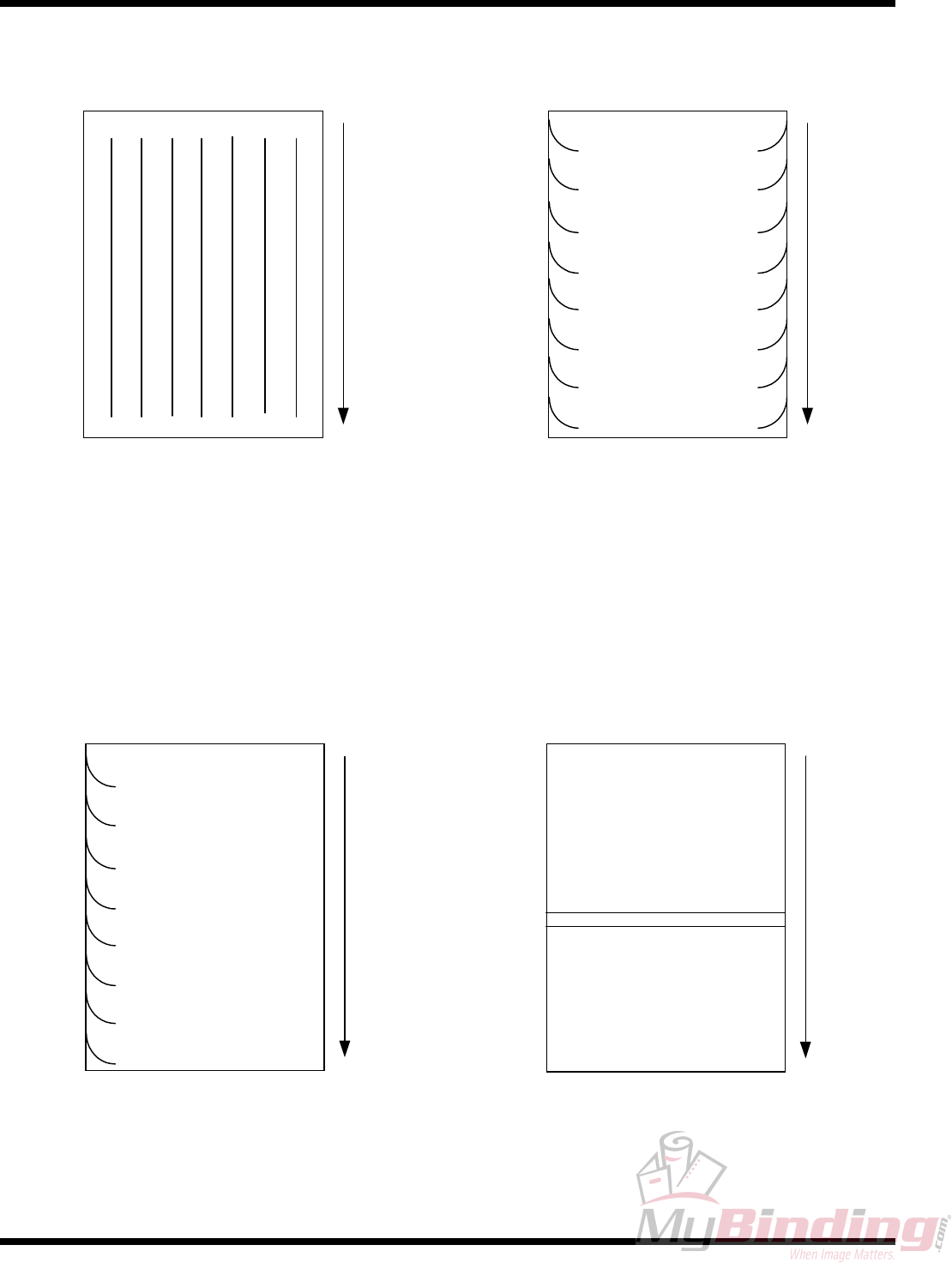
Page 7 - 2
Troubleshooting F 60 H Operation and Maintenance Manual
© April 2001 General Binding Corporation
Problem: Straight waves in the output
Hints: • Check operational settings for materials
being used.
Problem: Waves on only one side of the output
Hints: • Check the nip setting of main rolls
• Check for even paper tension
Problem: Angled waves in the output on both sides
Hints: • Check for insufficient main roller pressure
• Check the main roller nip settings
Problem: Indent waves in output after the pull rollers
Hints: • Output travel was hindered
• Allow output to cool before handling
• Check operating temperatures of material

Page 7 - 3
TroubleshootingF 60 H Operation and Maintenance Manual
© April 2001 General Binding Corporation
7.2 Film problems
The following is a list of common film problems
you may encounter.
For definitions of terminologies, please refer to
7.4 Glossary of terminology.
Pressure sensitive
Problem : Silvering in the laminate
Hints : • Add 100 - 120oF ( 37 - 49oC ) to the
temperature
• Increase pressure to laminating rolls
Problem : Tunneling
Hints : • Print should be wound image side out.
• Do not roll tightly
• Do not roll at all.
Problem: Delamination
Hints: • Check operating pressures
• Check operating speed
• Laminate compatibility with ink
• Ink compatibility with paper
Lo-Melt laminates
Problem: Blistering within the image
Hints: • Increase the speed
• Decrease the operating temperature
• Allow a longer drying time for the image
Problem: Silvering in the laminate
Hints: • Decrease the speed
• Increase the operating temperature
Problem: Delamination
Hints: • Check operating temperatures
• Check operating speed
• Laminate compatibility with ink
• Ink compatibility with paper
Mounting
Problem : Image creases when mounting
Hints : • Press down on leading edge from center
outwards.
• Be sure image is conformed to the roll
• Use a speed you are comfortable with
• Be sure even tension is supplied to the image
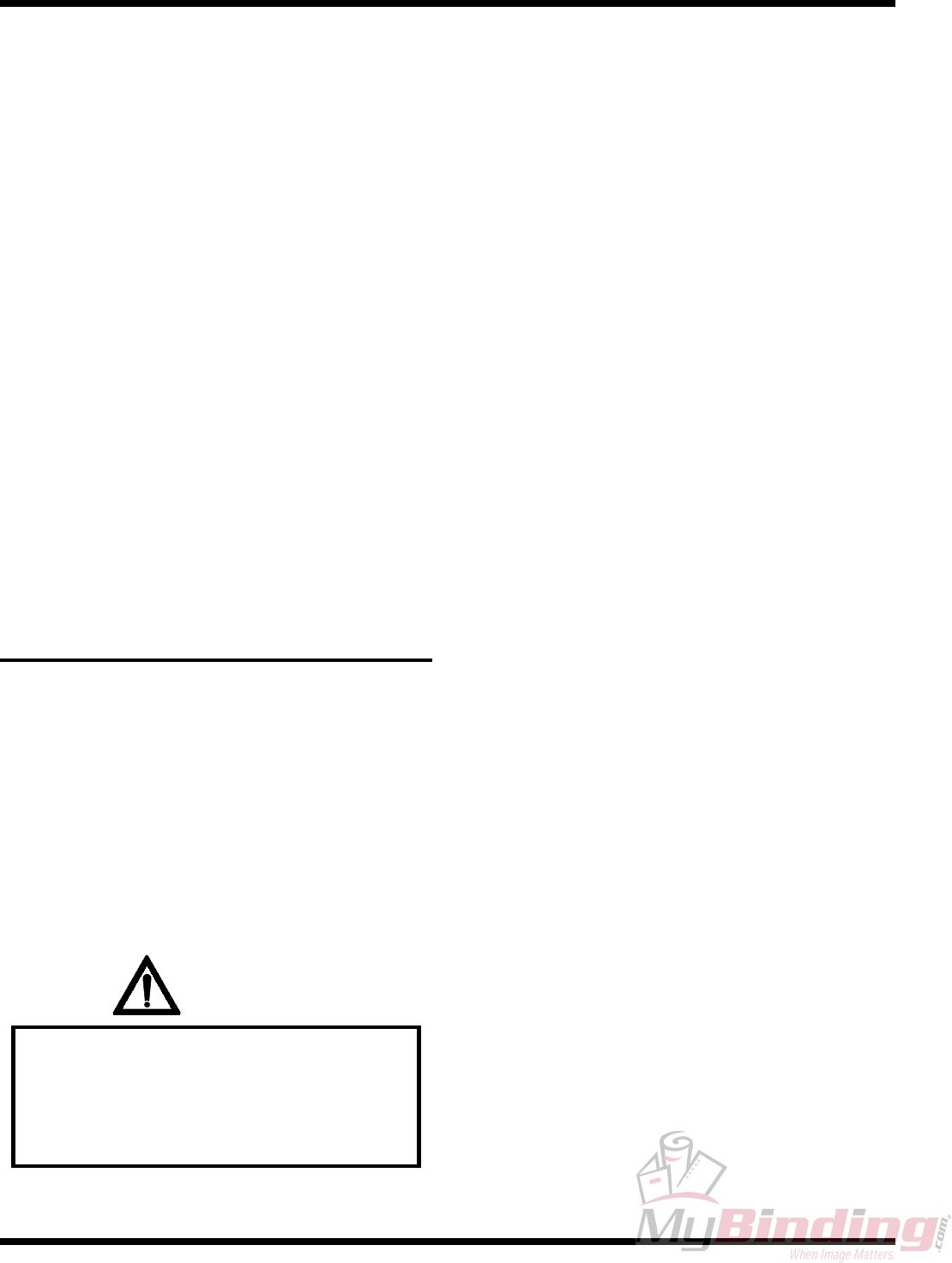
Page 7 - 4
Troubleshooting F 60 H Operation and Maintenance Manual
© April 2001 General Binding Corporation
7.3 Machine problems
Once the Hints are all checked, and your problem
still exists, a service call must be placed for a qualified
service personnel to fix the problem.
You may do this by dialing 1 ( 800 ) 790 - 7787.
This will connect you with GBC National Service dispatch.
You will be required to give the serial number of your
machine when placing a service call.
A space below has been provided to keep this
number readily available if and when needed.
My Falcon 60 H Laminator serial # is :
At no time does GBC Films Group suggest or
recommend that you attempt to fix the machine by
removing the cabinets or leg covers yourself.
WARNING
Do not wear ties, loose fitting clothing or
dangling jewelry while operating or
servicing the laminator. These items can get
caught in the nip and choke you or you can
be crushed or burned.
Problem : No illumination to the control panel
Hints : • Ensure an E-STOP has not been pushed
down
• Press RESET.
• Confirm that the MAIN POWER is to the
on position.
• Be sure power is supplied to the laminator
Problem : I can only operate using the footswitch.
Hints : • Ensure the PHOTO-EYE is not blocked.
• Place a service call to calibrate sensors.
Problem : I press ENGAGE, the rollers will not turn.
Hints : • Be sure a speed has been set.
• Make sure a motor direction has been
selected.
• Ensure the PHOTO-EYE is not blocked.
Problem : Jerking, stuttering, or excessive noise from
the laminator.
Hints : • Check for excessive brake tension
• Confirm that the rolls of laminate are on
correctly.
• Check for proper chain tension.
• Place a service call.

Page 7 - 5
TroubleshootingF 60 H Operation and Maintenance Manual
© April 2001 General Binding Corporation
7.4 Glossary
The glossary can help you in understanding some
of the terminology used when referring to the laminator,
applications, or troubleshooting aspects of the machine.
Blistering
A condition where the paper coating is bubbled
up from the image paper causing a “blister”. It is created
by using excessive heat during the lamination process.
Blistering is most commonly found with photographic and
ink jet media.
Bond strength
Refers to one of three conditions; 1) the anchor
strength of adhesive to laminate substrate, 2) the anchor
strength of the laminating film to the product that has been
laminated, or 3) when two layers of film are laminated
together, the strength of the adhesive to adhesive bond.
Center mount
A mounting technique where an image is mounted
centrally on a substrate to provide a decorative border.
Coiling
A term used to describe an image rolling up on
itself. This is caused by differences in the brake tension
used between the upper and lower laminates during and
application process.
Cold laminate
Film that does not require heat to activate the
adhesive. Please see P.S.A. for more information.
Craft paper
A strong brown paper commonly used for single
sided applications.
D waves
A term used to describe a wave pattern caused,
generally, by incorrect paper tension.
Delamination
Refers to either one of two conditions; 1) the
adhesive separating from the laminate substrate, or 2) the
laminate separating from the product being laminated.
Edgewrap
A mounting technique where the image wraps
around the edges of the mounting substrate so as to provide
a finished edge.
Encapsulation
When an image is completely encased in laminating
film, it is encapsulated. A border of laminate on laminate
exists around the perimeter of the product.
Film
A two part material consisting an adhesive layer
and a substrate. The adhesive and the substrate may or
may not be clear. This is the material used for lamination.
Please refer to laminate.

Page 7 - 6
Troubleshooting F 60 H Operation and Maintenance Manual
© April 2001 General Binding Corporation
Foamboard
A material commonly used as a mounting
substrate. It is made up of foam sandwiched between
two layers of paper, or paper like media.
Inkjet
A term used to describe a type of printing where
an ink is projected topically onto a paper or paper like
media. This is a non contact form of printing.
Laminate
A two part material consisting of an adhesive layer
and a substrate. The adhesive and the substrate may or
may not be clear. This is the material used for lamination.
Lo-Melt films
This is another type of thermal laminate. The name
Lo-Melt describes this product simply. Low heat to
activate ( melt ) the adhesive. Any temperature below
boiling point is typically considered to be low.
Main rollers
These are the rolls that perform the actual
lamination. They are rolls capable of being heated in
thermal roll laminators and are usually larger in diameter
than the pull rolls.
Media
Term used to describe the materials used to print
an image, i.e. the papers, inks, toners, etc.
Mount adhesive
A term used to describe a two sided pressure
sensitive adhesive used in mounting images to various
substrates. This material can come with one or two release
liners and may be optically clear for face mounting
applications.
Nip
The interrelationship of any two rolls. The distance
between the closest points of the two rolls is referred to
as the nip of the rolls.
P.S.A.
Stands for Pressure Sensitive Adhesive. An
adhesive that requires no heat to activate, only pressure.
It is employed by removing a protective release liner and
then pressed onto the material to be laminated. This type
of film is commonly used on materials that are temperature
sensitive.
Release liner
A coated paper or other media used to protect
the adhesive side of a pressure sensitive material.
Rewind
A system that rolls up media. The rewind tube (s)
used on the Falcon 60 H laminator is a prime example.
Roll to roll
On a laminator, this means the roll of images, upper
roll of material and the lower roll of material can be fed by
the machine and wound on a rewind roll by the machine.

Page 7 - 7
TroubleshootingF 60 H Operation and Maintenance Manual
© April 2001 General Binding Corporation
Scarring
The visual effect of folding papers or laminates
and breaking the surface. When done to a printed material
it will be seen as a white crack in the image.
Second surface
A term to denote the back side of a substrate.
Commonly referenced when discussing front mounted
images to a clear substrate with an optically clear mount
adhesive.
Silvering
A term used to describe one of two occurrences;
1) air bubbles trapped between the product and a thermal
laminate, generally caused by insufficient heat being applied
to the laminator or 2) the adhesive not fully activated in a
pressure sensitive film, which will disappear once the
adhesive is fully activated. This activation process can be
sped up if a small amount of heat is applied during the
application.
Substrate
The material to which an adhesive is to be bonded.
In film, the substrate is the polyester and in mounting, the
substrate is the material being mounted to.
Tunneling
When a laminated image is rolled up for any period
of time and the laminate separates from the image.
Generally in a pattern that follows the direction the
laminated image was rolled up in. This is very common
with pressure sensitive laminates and finished products
that have been wound tightly.
Unwind
A system that unwinds media. Unwinds are used
on all laminators to dispense laminate for lamination.
Web
The path that rolled media unwinding from a supply
roll takes through a machine or array of rollers.

Page 7 - 8
Troubleshooting F 60 H Operation and Maintenance Manual
© April 2001 General Binding Corporation
This page intentionally left blank.
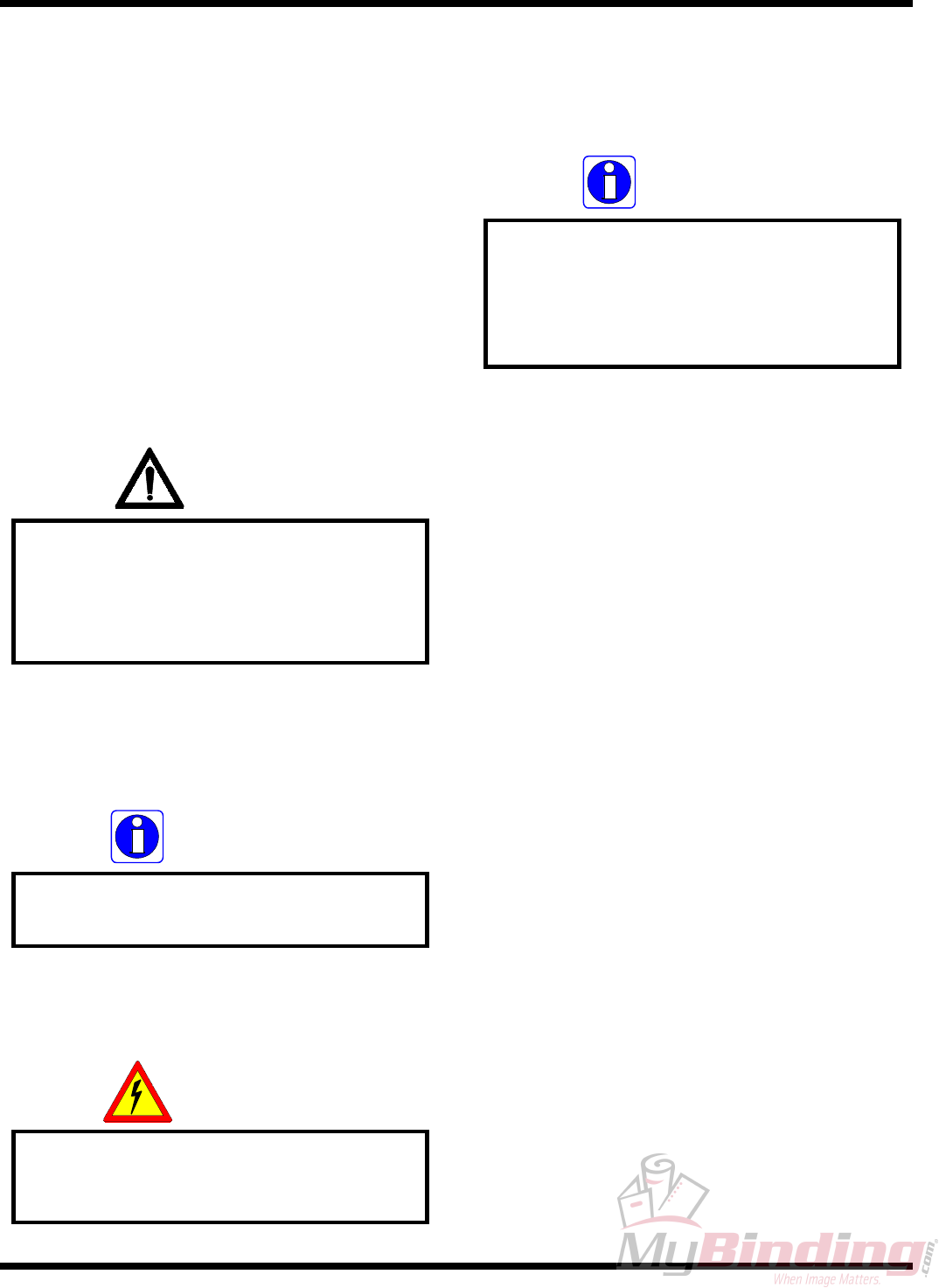
Page 8 - 1
MaintenanceF 60 H Operation and Maintenance Manual
© April 2001 General Binding Corporation
8.0 Maintenance
GBC Films Group laminators require minimal
maintenance. However, regular maintenance is essential
to keep any piece of precision machinery at peak
performance. A maintenance schedule and a section of
procedures are included in this section.
WARNING
Do not wear ties, loose fit clothing or
dangling jewelry while operating or
servicing the laminator. These items can get
caught in the nip and choke you or you can
be crushed or burned.
INFORMATION
Improper maintenance, can
result in poor output quality.
ELECTRICAL
SHOCK
Remove power from the laminator before
servicing. You can be severely shocked,
electrocuted or cause a fire.
8.1 Maintenance Schedule
Below is a recommended maintenance
schedule. Before performing any of the steps
listed, read through the procedures first.
Please follow the instructions pertaining to
the step you are performing.
INFORMATION
Daily
• Clean the rollers
( See cleaning in this section )
• Inspect the electrical cord for damage.
( If damaged, you should replace or repair it
immediately )
• Inspect the footswitch cord for damage.
( If damaged, you should replace or repair it
immediately )
Monthly
• Adjust the nip if needed.
( performed by service technician )
• Check the chain tension.
( performed by service technician )
• Inspect the area around the laminator for
possible hazards
( dust buildup, combustible items stored too
close, etc. )
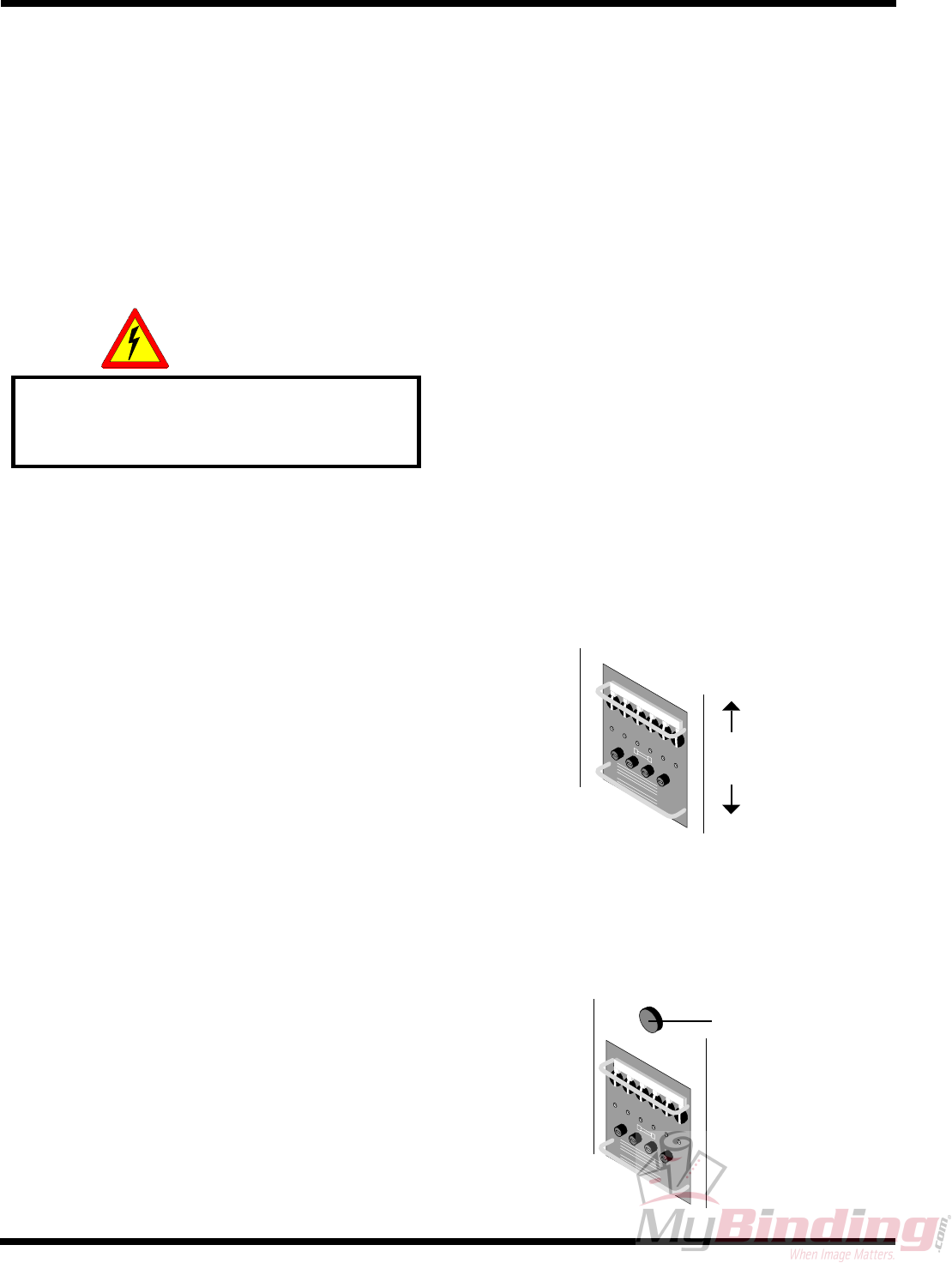
Page 8 - 2
Maintenance F 60 H Operation and Maintenance Manual
© April 2001 General Binding Corporation
Semi-Annual
• Lubricate the grease fittings, chain, and gears.
( performed by service technician )
• Check wire termination tightness.
( performed by service technician )
ELECTRICAL
SHOCK
Remove power from the laminator before
servicing. You can be severely shocked,
electrocuted or cause a fire.
8.2 Cleaning the rollers
Tools required
• Protective rubber gloves
( This will protect your hands from the isopropyl
alcohol )
• 80% isopropyl alcohol
( a mild dishwashing detergent and water may
be used instead )
• Rubber cement eraser
( a belt sander dressing block may be used
instead )
• Several 100% cotton terry cloths
( best for lint free cleaning )
a) Turn the main power to the ON position.
POWER
On
Off
b) Press machine RESET.
POWER
Reset
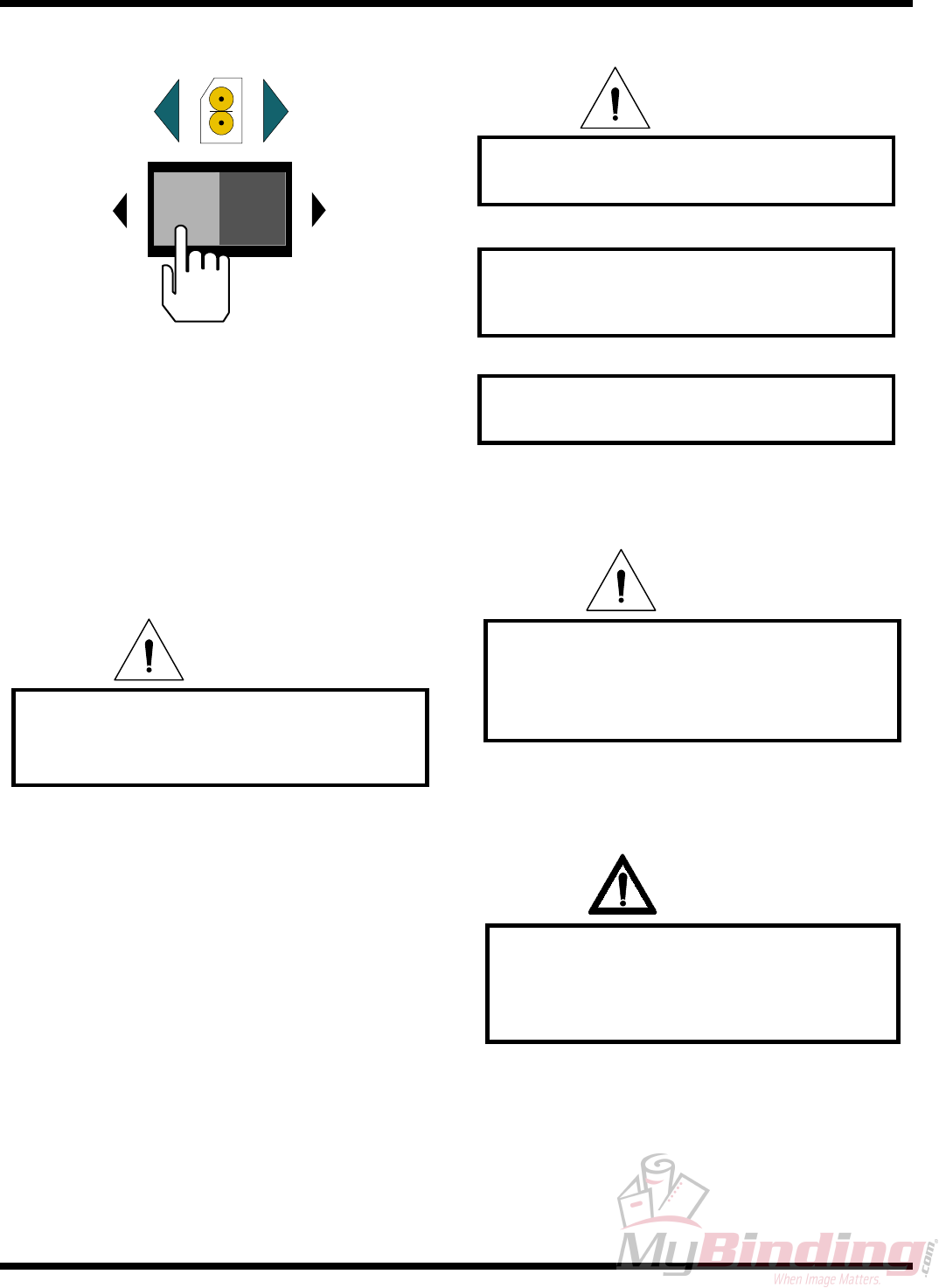
Page 8 - 3
MaintenanceF 60 H Operation and Maintenance Manual
© April 2001 General Binding Corporation
c) Set motor direction to REV.
(reverse) (forward)
d) For pressure sensitive adhesives: put the rubber
gloves on and use isopropyl alcohol and a
terry cloth towel to rub the adhesive off.
CAUTION
Excessive pressure can destroy the silicone
layer by pressing to hard or scrubbing
too long in one spot.
e) For thermal adhesives: while the laminator is at
normal operating temperature, put on the rubber
gloves and use the rubber cement eraser. This
allows the eraser to bead up the adhesive.
f) Wipe away the beads with isopropyl alcohol
and a cotton terry cloth.
CAUTION
Exercise care when cleaning the laminating
rollers with 80% isopropyl alcohol:
Use only in a well ventilated area
Wear rubber gloves
Use only on cool rolls
CLEANING HEATED ROLLERS CAN
IGNITE THE FUMES!
CAUTION
Do NOT pick or pull heat activated adhesive
off the rolls when they are cold. You can
cause irreparable damage to the
laminating rolls.
WARNING
When operating the laminator using the
footswitch, keep hands and fingers
away from the nip of the rollers.
You may be CRUSHED or BURNED!
d) Use the footswitch to rotate the rollers when
finished cleaning that area.

Page 8 - 4
Maintenance F 60 H Operation and Maintenance Manual
© April 2001 General Binding Corporation
8.3 Clean cabinets and covers
ELECTRICAL
SHOCK
Remove power from the laminator before
cleaning. You can be severely shocked,
electrocuted or cause a fire.
a) Use a damp cotton terry cloth ( water only ),
clean the exterior of the laminator.
b) If water is not strong enough, you may use a
mild dishwashing detergent with water and a
cotton terry cloth.
ELECTRICAL
SHOCK
Do not use liquid or aerosol cleaners on the
laminator. Do not spill liquid of any kind on
the laminator. You can be severely shocked,
electrocuted or cause a fire. Use only a damp
cloth for cleaning unless other wise
specified.
8.4 Clean the control panel
ELECTRICAL
SHOCK
Remove power from the laminator before
cleaning. You can be severely shocked,
electrocuted or cause a fire.
a) Use only a slightly damp ( water only ) non
abrasive cloth.
b) The same type of cloth used to clean eye
glasses may be used instead.
ELECTRICAL
SHOCK
Do not use liquid or aerosol cleaners on the
laminator. Do not spill liquid of any kind on
the laminator. You can be severely shocked,
electrocuted or cause a fire. Use only a damp
cloth for cleaning unless other wise
specified.
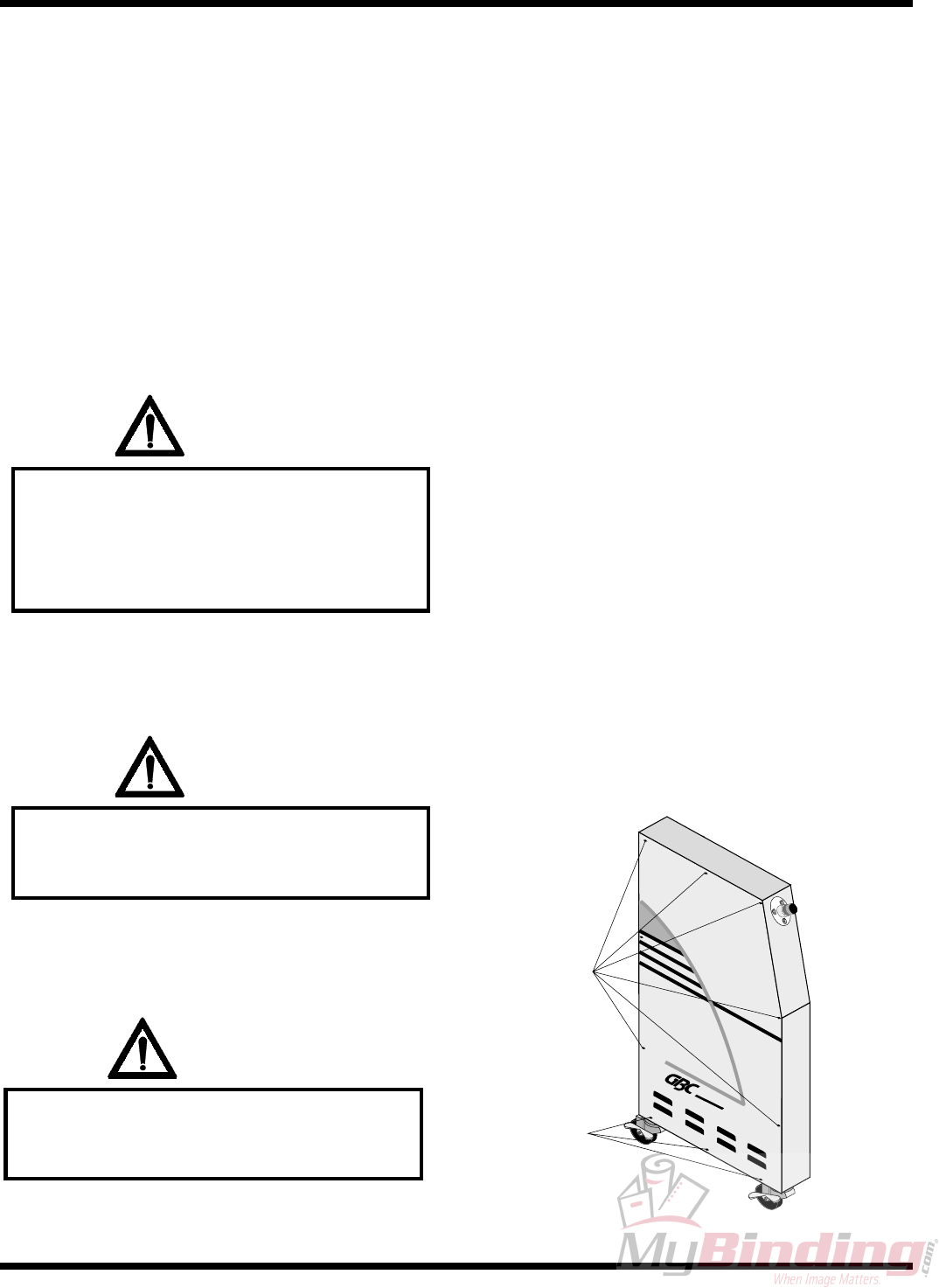
Page 8 - 5
MaintenanceF 60 H Operation and Maintenance Manual
© April 2001 General Binding Corporation
8.5 Chain tensioning
A properly tensioned chain should have a 1/2 in
( 1.3 cm ) of total play at the longest stretch of the chain.
Read and understand the precautions below before
attempting any service work.
WARNING
Do not wear ties, loose fit clothing or
dangling jewelry while operating or
servicing the laminator. These items can get
caught in the nip and choke you or you can
be crushed or burned.
Remove ALL power to the laminator before
removing any cabinet covers.
You may be shocked or electrocuted!
WARNING
WARNING
Always practice lock out/ tag out procedures
when performing any type of service or
maintenance work on the machine.
Tools required
• 1/8 inch allen wrench
• 7/16 inch wrench or socket
a) Ensure all power to the laminator has been
removed.
b) Use proper lock out/ tag out procedure.
c) With a 1/8 in. allen wrench, remove the drive
side cabinet cover by;
1) Loosen the three screws along the
bottom.
2) Remove the seven screws along the
top and sides of the cover.
2
PRO-TECH
F 60 H
1
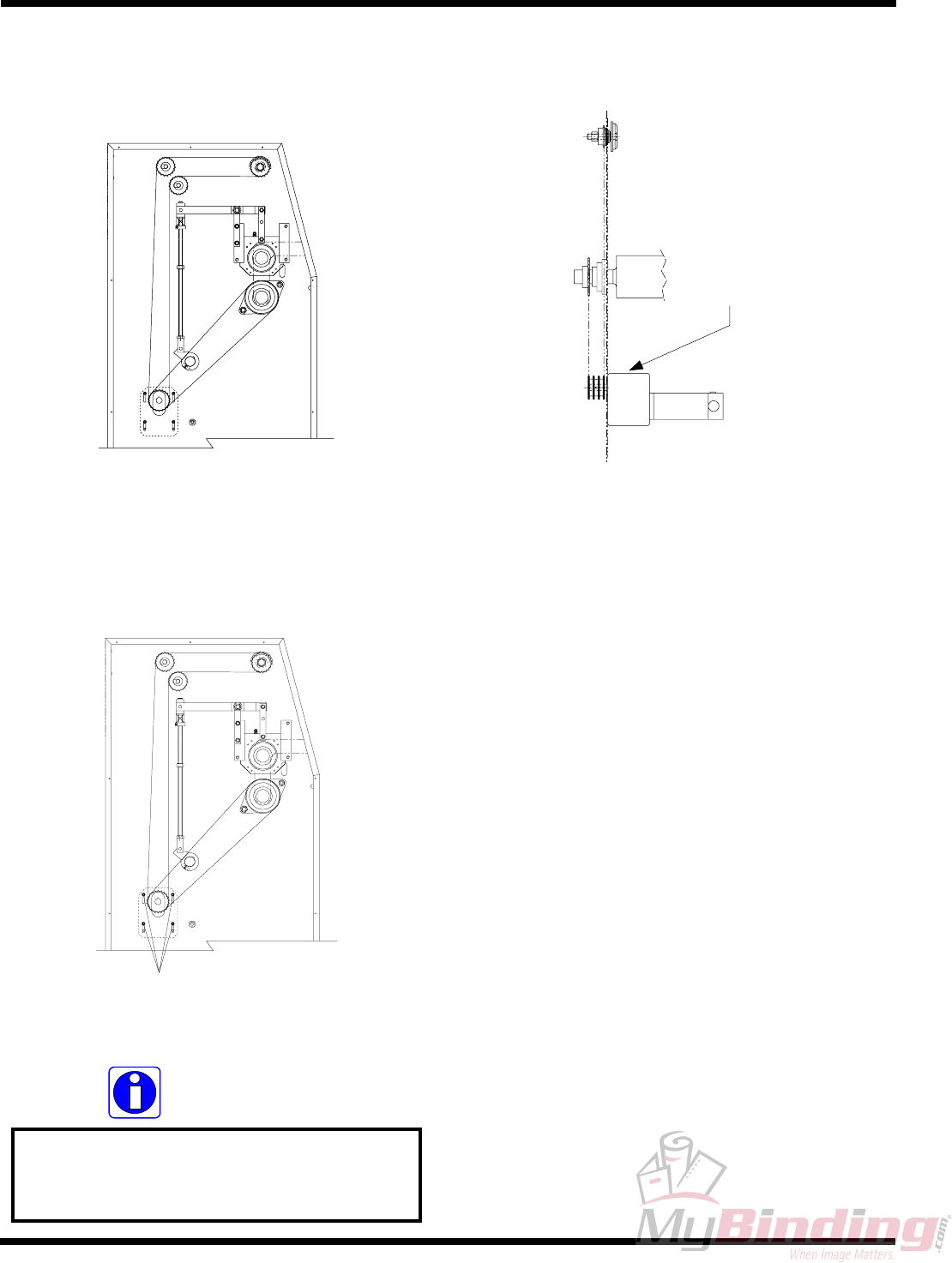
Page 8 - 6
Maintenance F 60 H Operation and Maintenance Manual
© April 2001 General Binding Corporation
d) Check the primary chain ( outer ) and the
secondary chain ( inner ) for proper chain
tension.
Primary chain
Secondary chain
e) If the chains require tensioning, loosen the four
motor mount bolts with a 7/16 in. wrench.
Four bolts
INFORMATION
The motor controls the tension of the both
chains. If one is chain is still too loose,
a half link may be removed.
f) Press firmly down on the motor housing and
tighten the motor mount bolts.
Press
firmly
here
g) Check the primary chain ( outer ) and the
secondary chain ( inner ) again for proper chain
tension.
h) Replace the drive side cabinet cover and restore
power to the machine.
